| |
|
|
|
|
|
|
|
| Working Party on Agricultural Quality Standards |
| |
| LIST OF DISEASES AND PESTS |
| |
|
|
|
|
|
|
|
This text presents a list of the major diseases affecting potatoes, as well as a basic description of each disease and the extent of certification measures for each disease. In the Standard, tuber rots caused by Ralstonia solanacearum (brown rot) and Clavibacter michiganensis spp. sepedonicus (ring rot) are considered separately from other tuber rots in respect of minimum quality for lots in the Standard. Other tuber rots are generally classified as dry or wet, as defined below, and the certification measures applied for each rot disease are set out in the list under "Status in UNECE Standard".
More detailed information on the symptomology and epidemiology of the diseases can be obtained from the following textbooks:
Compendium of Potato Diseases (2001, 2nd edition). W.R. Stevenson and others, eds. St. Paul, Minnesota, USA, American Phytopathological Society.
European Handbook of Plant Diseases (1998). I.M. Smith and others, eds. Oxford, UK, Blackwell Scientific Publications.
Diseases, Pests and Disorders of Potatoes in Israel (2006, 2nd edition). L. Tsror and S. Warshavsky, eds. Israel Vegetable Growers Organization. Website: www.yerakot.il. E-mail: [email protected].
Fiches descriptives des maladies et ravageurs de la pomme de terre (2000). France, FNPPT (Fédération Nationale des Producteurs de Plants de Pommes de Terre)/GNIS (Groupement National Interprofessionel des Semence et Plants).
Kartoffel-Krankheiten, Schdlinge und Unkruter (2003). W. Radke, W. Reickmann and F. Brendler, eds. Gelsenkirchen, Verlag Thomas Mann.
Maladies et ravageurs de la pomme de terre (1991). W. Radke and W. Rieckmann, eds. Translated and adapted into French by M. Magnenat. Gelsenkirchen-Buer, Verlag Thomas Mann.
Pests and Diseases of Potatoes. A Colour Handbook (2008). Stuart Wale, Bud Platt & Nigel D. Cattlin. Manson Publishing.
Potato Diseases (2005). A. Mulder and L.J. Turkensteen, eds. The Hague, NIVAP. Website: www.nivap.nl. |
 |
 |
 |
 |
 |
 |
 |
 |
Disease
Maladie
Болезнь |
Agent
Agent
responsable
Вредные
организмы |
Status in UNECE Standard
Statut dans la norme
CEE-ONU
Статус в стандарте
ЕЭК ООН |
Recommended
diagnostic method
Méthode d’analyse recommandée
Рекомендуемый метод диагностики |
General disease description
Description générale de la maladie
Общее описание болезни |
Tuber symptom
Symptômes sur les tubercules
Симптомы на клубнях |
Plant syptoms
Symptômes sur la plante
Симптомы на ботве |
Comment
Observation
Замечания |
| TUBER ROT POURRITURE DU TUBERCULE КЛУБНЕВАЯ ГНИЛЬ |
| |
|
|
|
Dry rot: externally, the tubers will have dry, necrotic or discoloured patches on the surface. Internally, the disease will consist of brown necrotic areas surrounding fungus-lined cavities or dry powdery tissue. Examples of such rots are gangrene, Fusarium dry rots and tuber late blight.
Wet/soft rot: externally, the diseased tissue will appear discoloured, wet and soft to the touch, often exuding moisture and producing a range of odours, depending on the causal organism. In such cases, the internal tissue will have collapsed into a wet pulp. Examples of such rots are bacterial soft rots, pink rot, watery wound rot ("leak") and rots triggered by late blight or frost damage. |

 |
|
|
| FUNGUS CHAMPIGNONS ГРИБЫ |
| Potato wart disease |
Synchytrium
endobioticum |
Zero tolerance |
Visual observation of tubers and stem base |
Tuber: tumours
Plant: tumours and galls on stolons and stem base |
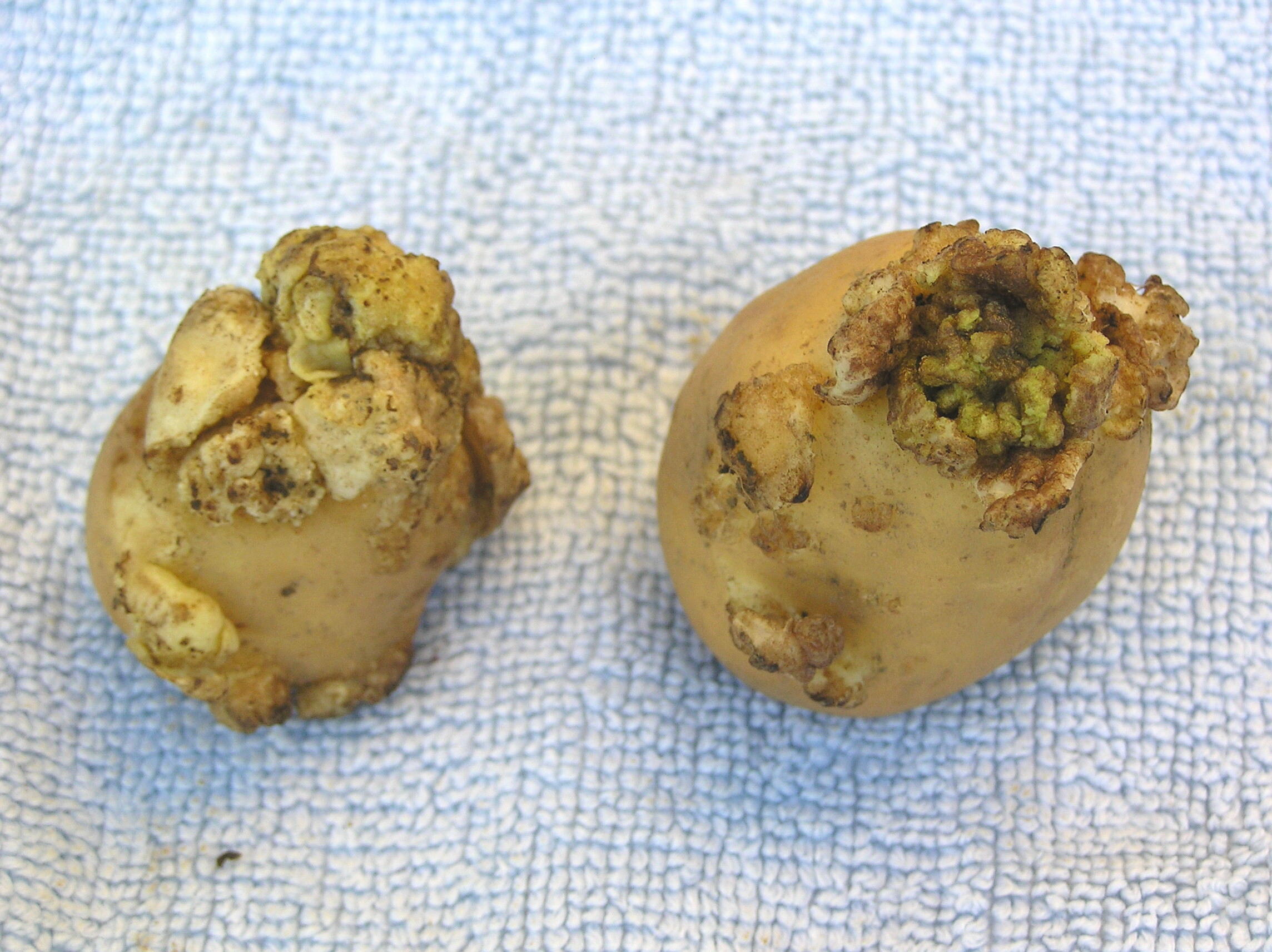 |
 |
|
Galle verruqueuse
ou gale noire |
Synchytrium
endobioticum |
Tolérance zéro |
Observation visuelle des tubercules et de la base des tiges |
Tubercules: tumeurs
Plante: tumeurs et galles au niveau des stolons et de la base des tiges |
|
| Рак картофеля |
Synchytrium
endobioticum |
Нулевой допуск |
Визуальный осмотр клубней и основания стебля |
Клубень: наросты
Ботва: наросты на столонах и основании стебля |
|
 |
| Late blight |
Phytophthora
infestans |
Tolerance for wet or dry rot |
Visual observation of plants and tubers |
Tuber: rot at harvest and in storage. A reddish-brown granular rot develops under the skin into the centre of tubers.
Plant: necrosis of leaves and stems. Stem lesions of late blight resulting in stem cracking. |
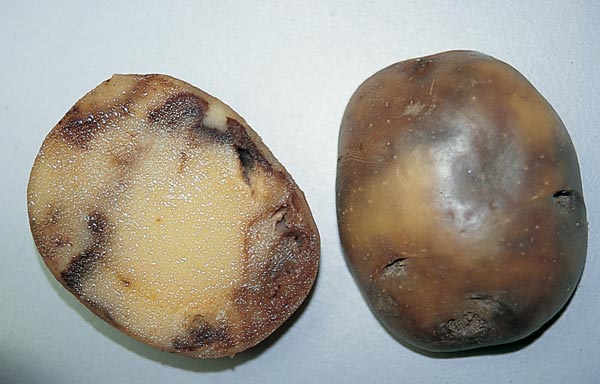
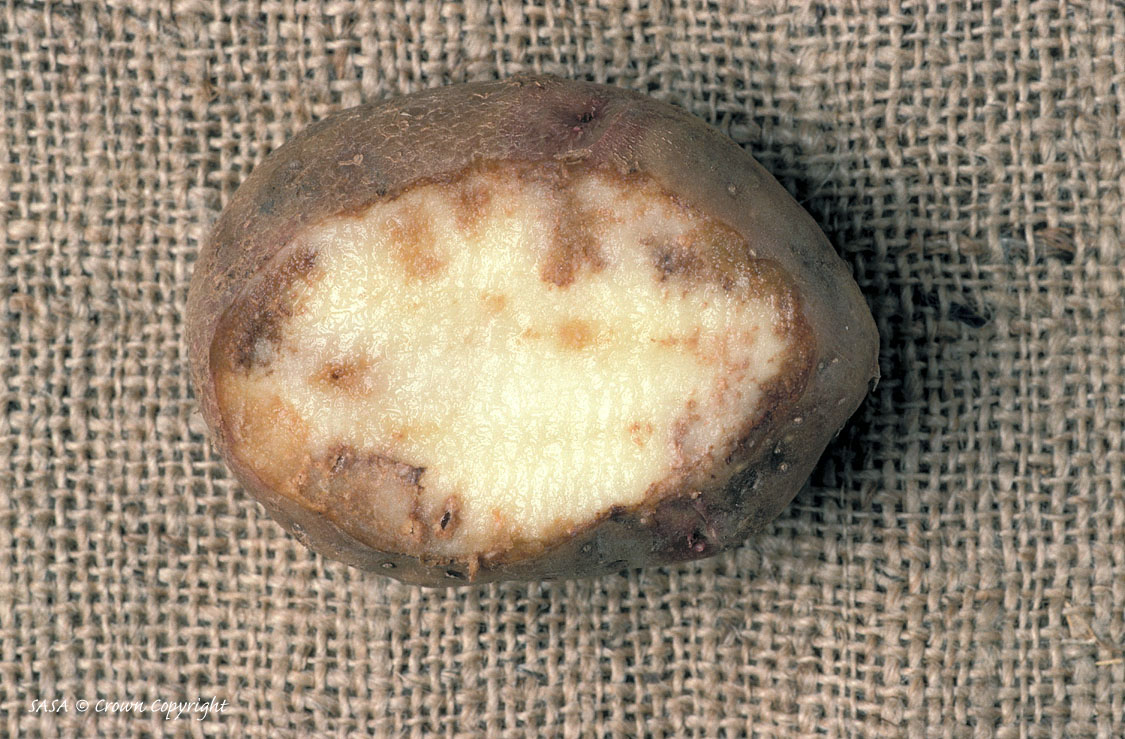 |
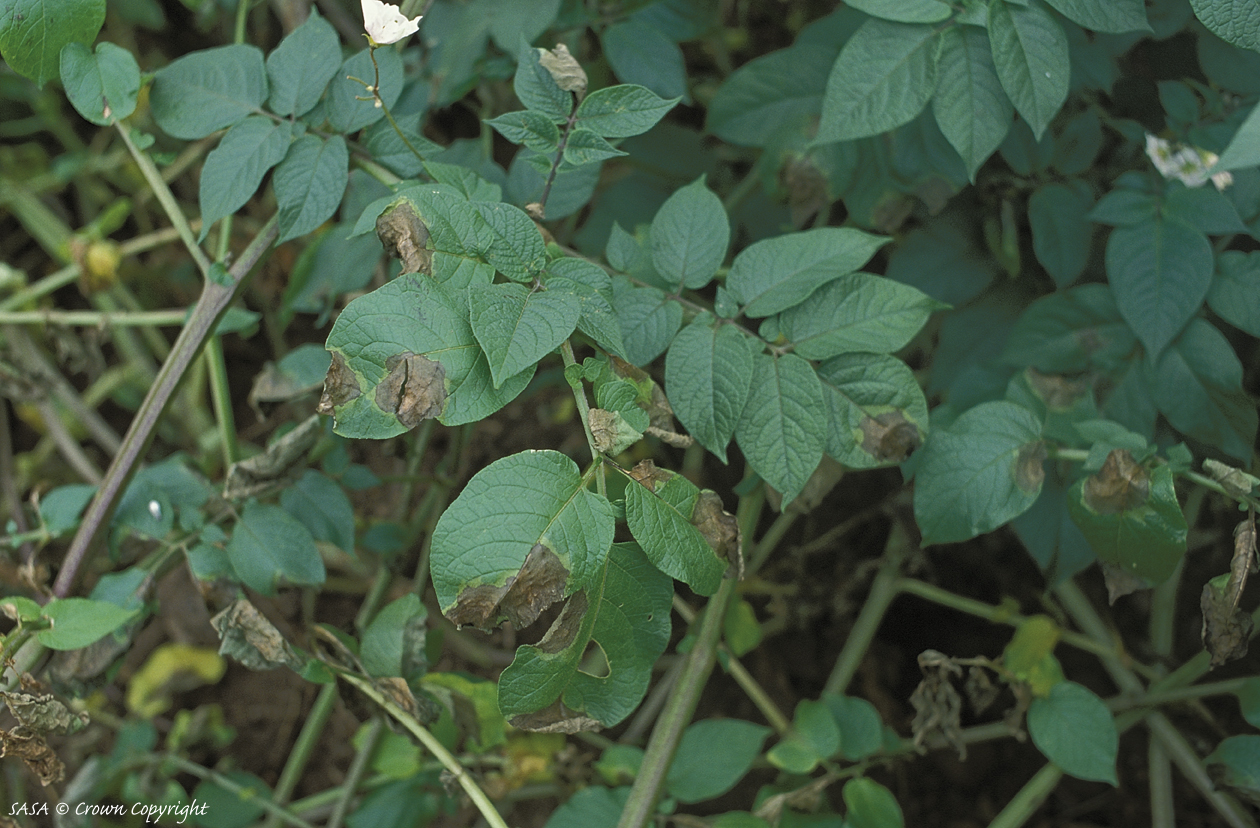

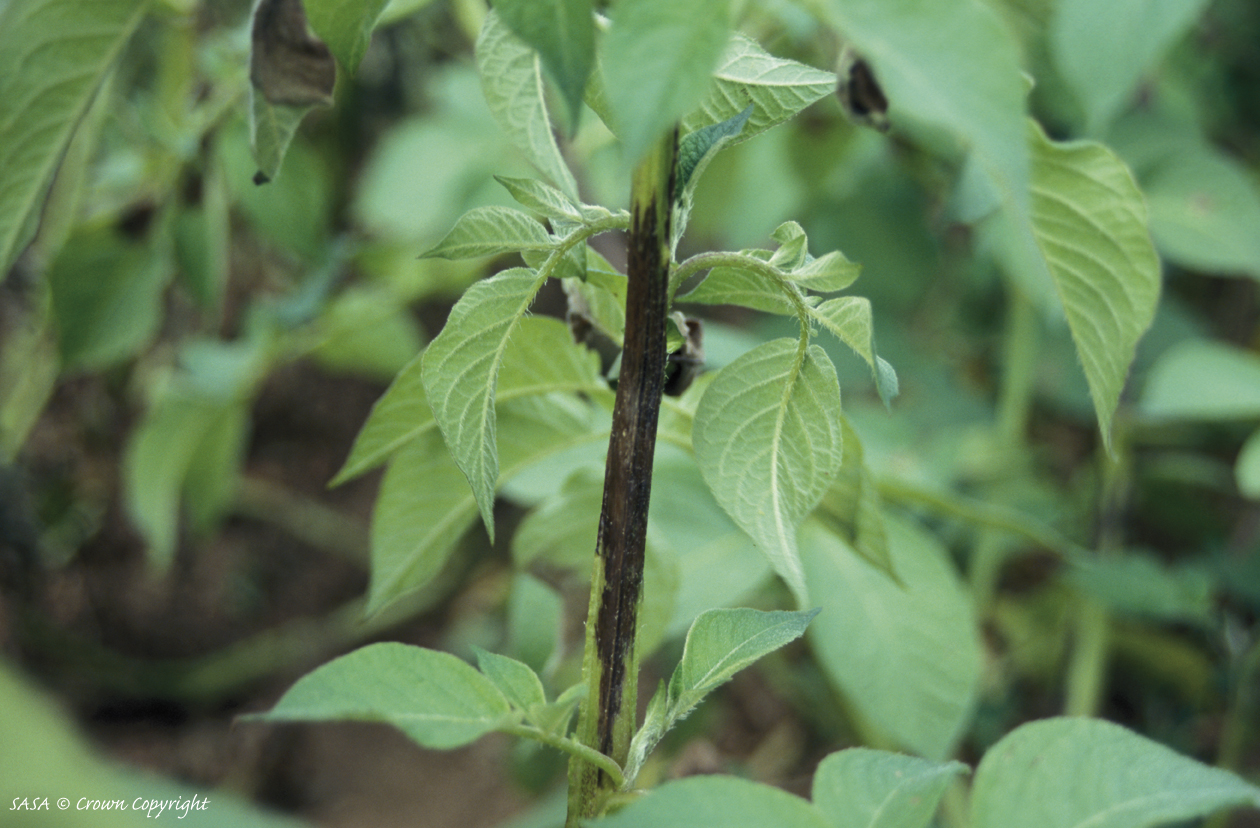 |
|
| Mildiou |
Phytophthora
infestans |
Tolérance définie (pourriture humide ou sèche) |
Observation visuelle des plantes et des tubercules |
Tubercules: pourriture à la récolte et en cours de conservation
Plante: nécrose des feuilles, tiges et les bouquets floraux |
|
| Мучнистая роса |
Phytophthora
infestans |
Допуск для мокрой или сухой гнили |
Визуальный осмотр растений и клубней |
Клубень: появление гнили при сборе урожая и хранении. Красновато-коричневатая гниль развивается под кожурой к центру клубня.
Ботва: некроз листьев и стеблей. Стебли могут растрескиваться |
|
 |
| Dry rot |
Fusarium solani var.
coeruleum |
Tolerance |
Visual observation of tubers and identification on specific medium |
Tuber: storage rot.
Circular rot with concentric wrinkles and white, orange or blue mycelial growth on surface of rot.
Light brown rot with a diffuse edge develops from skin inwards.
Plant: non-emergence or weak plants |
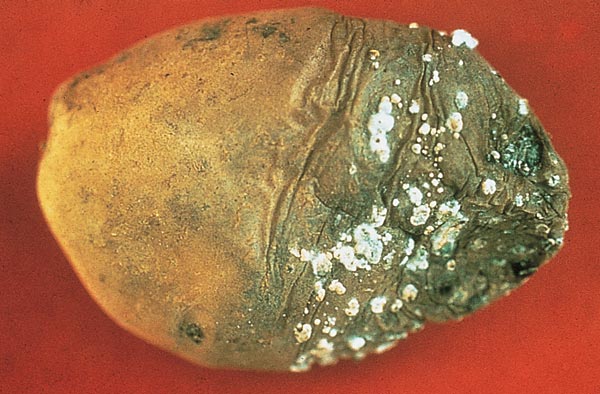
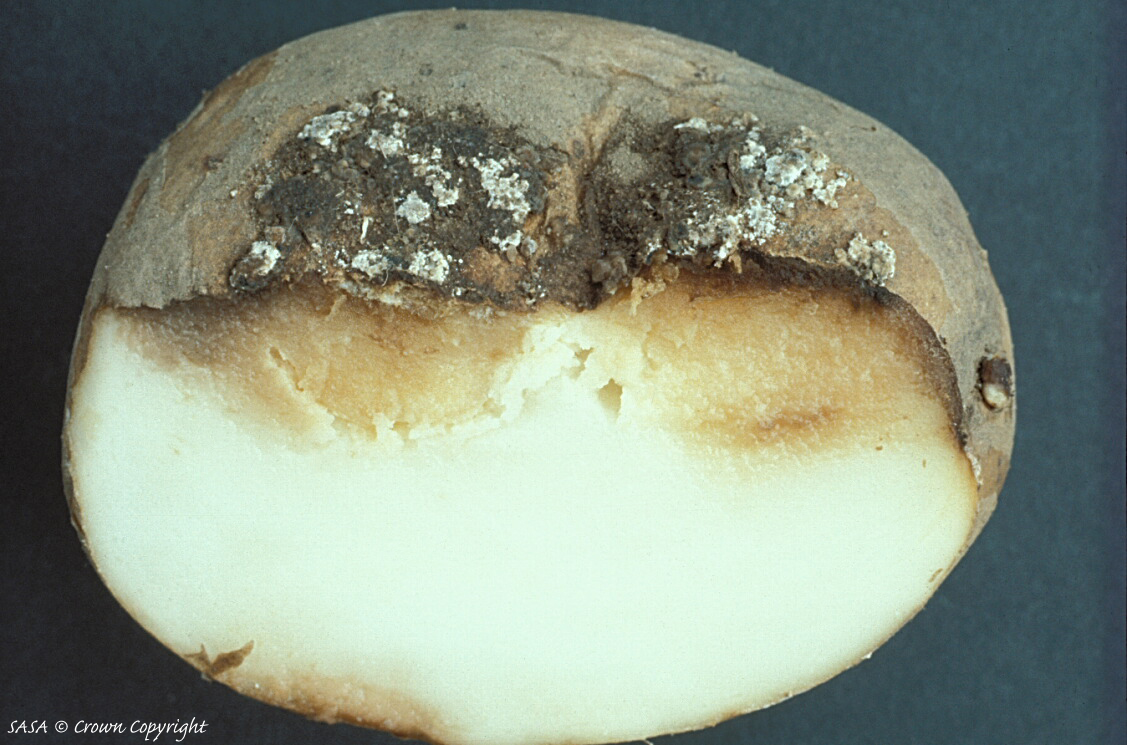 |
|
|
| Fusariose |
Fusarium solani var.
coeruleum |
Tolérance |
Observation visuelle des tubercules et identification sur milieu sélectif |
Tubercules: pourriture apparaissant en cours de conservation accompagnées des coussinnets mycéliens de couleur claire
Plante: non levée ou manque de vigueur |
|
| Фузариоз клубней
(сухая фузариозная гниль клубней) |
Fusarium solani var. coeruleum |
Допуск |
Визуальный осмотр клубней и выявление при отборе |
Клубень: гниение при хранении. Кольцевая гниль с концентрическими морщинами и белым, оранжевым или голубым грибковым налетом на поверхности гнили. Светло-коричневая гниль развивается от кожуры внутрь
Ботва: невсхожесть или слабость растений |
|
|
 |
| Dry rot |
Fusarium sulphureum |
Tolerance |
Visual observation of tubers and identification on specific medium |
Tuber: storage rot.
Small lesions develop at wounds and expand producing symptoms externally similar to gangrenei.e. slighty depressed with a wavy edge. Internally lesions develop cavities filled with grey powdery tissue.
Plant: non-emergence or weak plants |
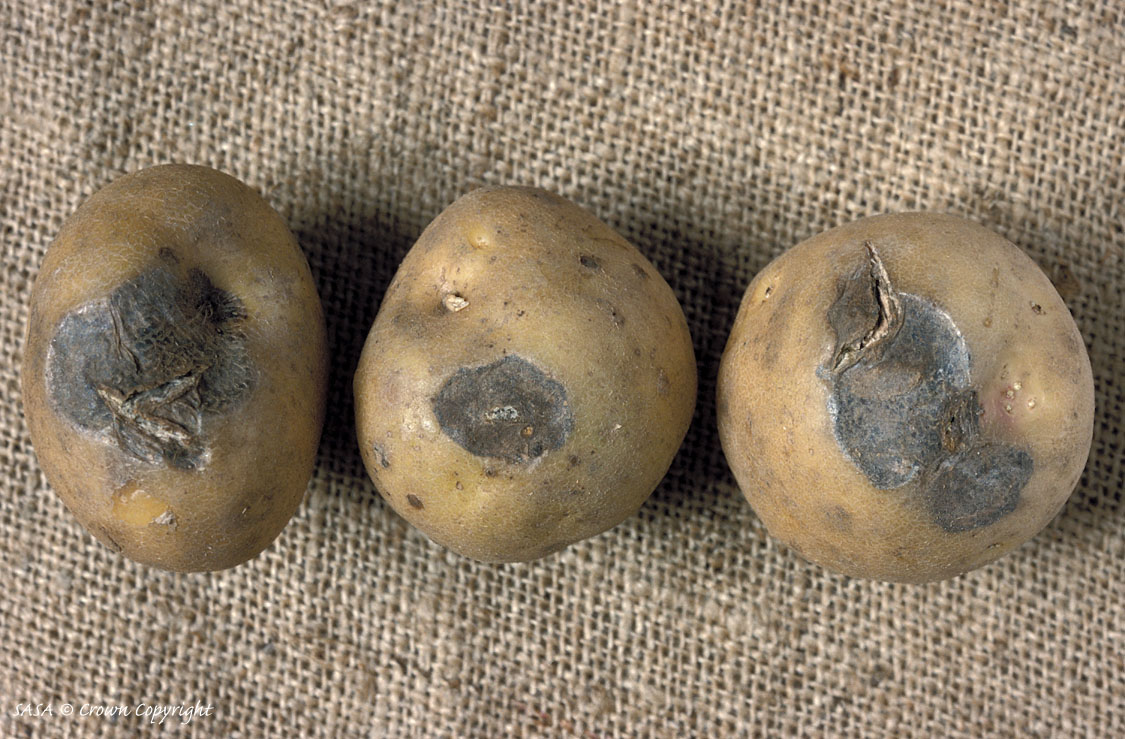
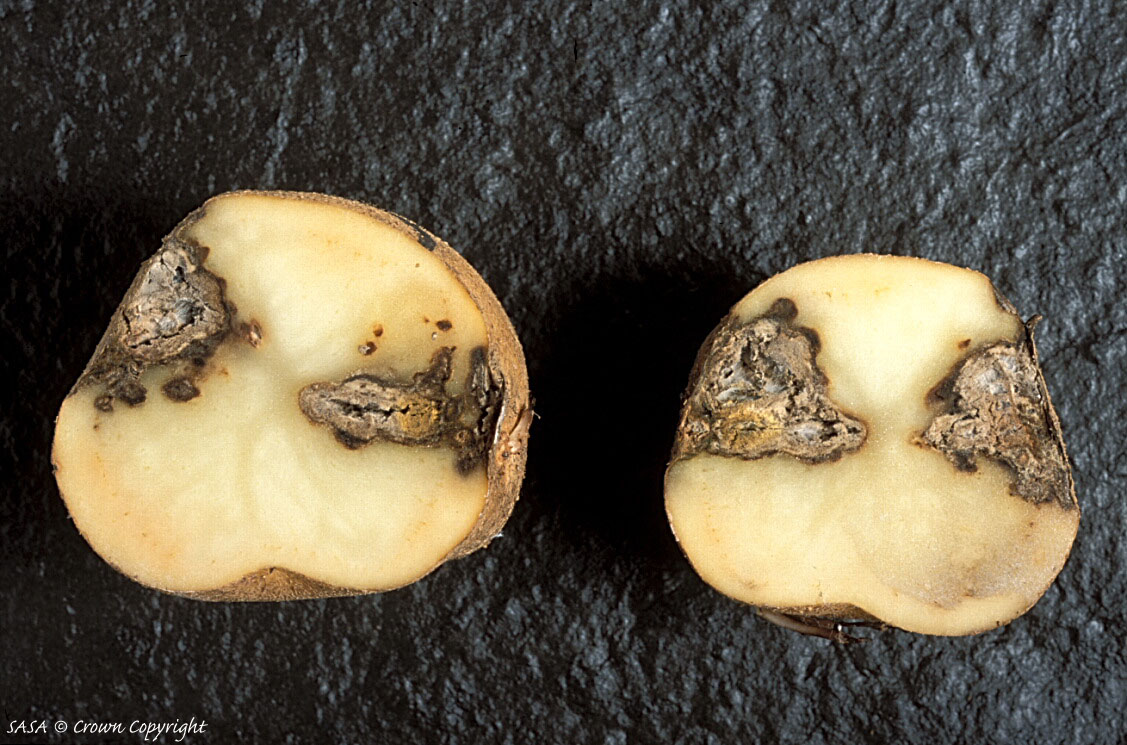 |
|
|
| Fusariose |
Fusarium sulphureum |
Tolérance |
Observation visuelle des tubercules et identification sur milieu sélectif |
Tubercules: pourriture apparaissant en cours de conservation accompagnées des coussinnets mycéliens de couleur claire
Plante: non-levée ou manque de vigueur |
|
| Фузариоз клубней |
Fusarium sulphureum |
Допуск |
Визуальный осмотр клубней и выявление при отборе |
Клубень: гниение при хранении. Небольшие поражения развиваются на месте повреждений с внешними симптомами схожими с фомозом: легкая вдавленность с волнистыми краями
Ботва: невсхожесть или слабость растений |
|
 |
| Dry rot |
Fusarium avenaceum
and other F. spp |
Tolerance |
Visual observation of tubers and identification on specific medium |
Tuber: storage rot. Symptoms tend to be similar to those for F.solani var. coeraleum although rots are often smaller and affected tissue is dark brown as illustrated for F.avenaceum
Plant: non-emergence or weak plants |
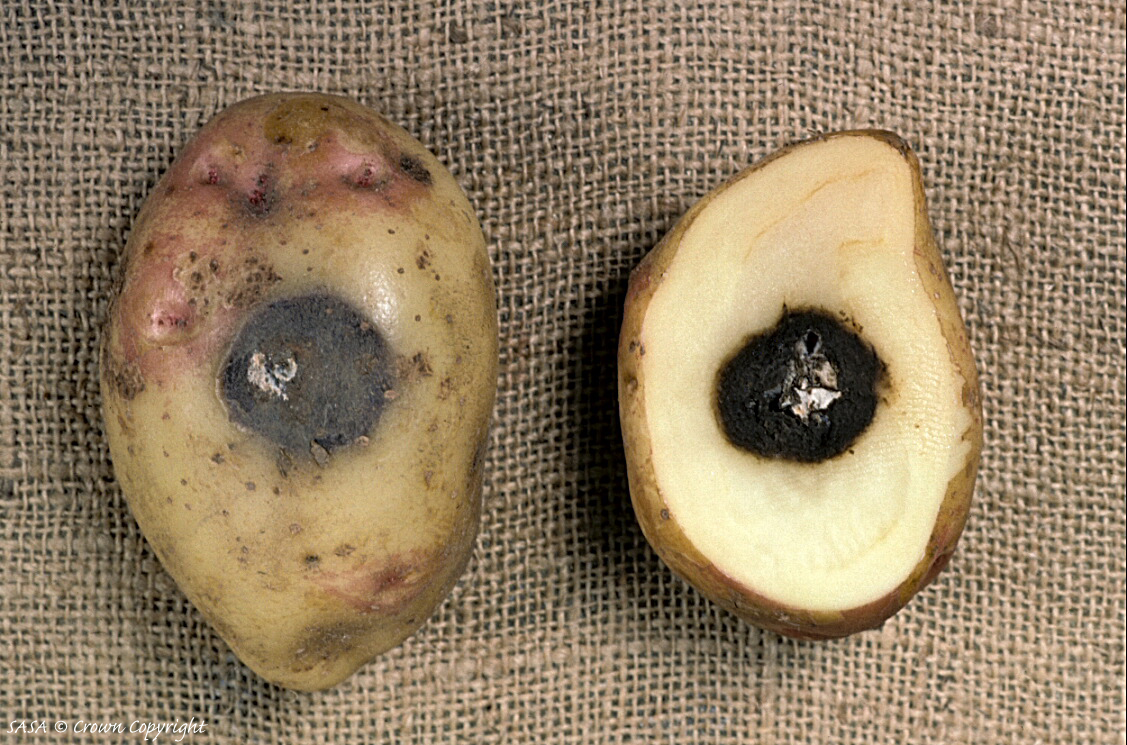 |
|
|
| Fusariose |
Fusarium avenaceum
et autres F. spp |
Tolérance |
Observation visuelle des tubercules et identification sur milieu sélectif |
Tubercules: pourriture apparaissant en cours de conservation. Symptôme similaires à F.solani var. coeraleum mais les pourritures sont souvent plus petites et le tissue affecté et brun foncé, comme c’est montré pour F.avenaceum
Plante: non-levée ou manque de vigueur |
|
| Фузариоз клубней |
Fusarium avenaceum
и другие F. spp |
Допуск |
Визуальный осмотр клубней и выявление при отборе |
Клубень: гниение при хранении. Симптомы как при F.solani var. coeraleum, хотя размер гнили часто меньше, и пораженная ткань имеет темно-коричневый цвет как от F.avenaceum
Ботва: Невсхожесть или слабость растений |
|
 |
| Gangrene |
Phoma foveata
and other Phoma spp. |
Tolerance for dry rot |
Visual observation of tubers and identification on specific medium |
Tuber: storage rot. Initial lesions are round, dark and slightly depressed, often like a thumb mark. As lesions develop they become black and sunken with an irregular wavy edge. Black pycnidia can form on the surface. Rotted tissue is generally brown or black with a well defined margin between healthy and diseased tissue. Cavities are usually lined with purple, yellow or white mycelia.
Plant: non-emergence or weak plants |
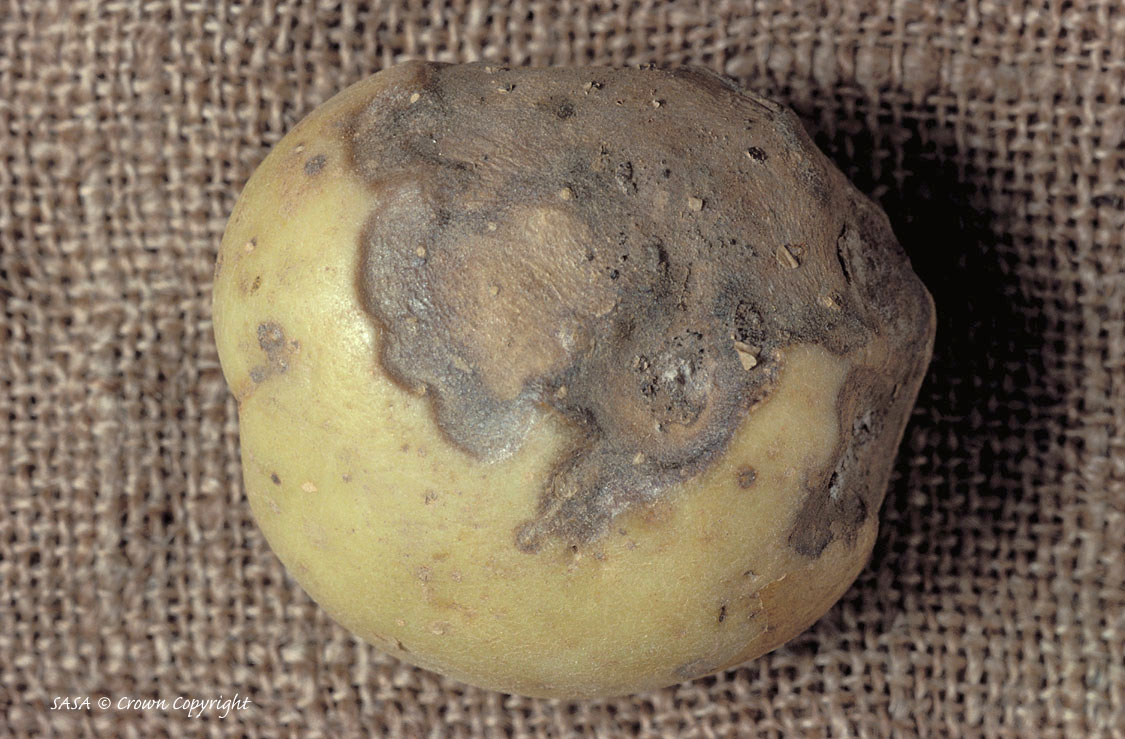
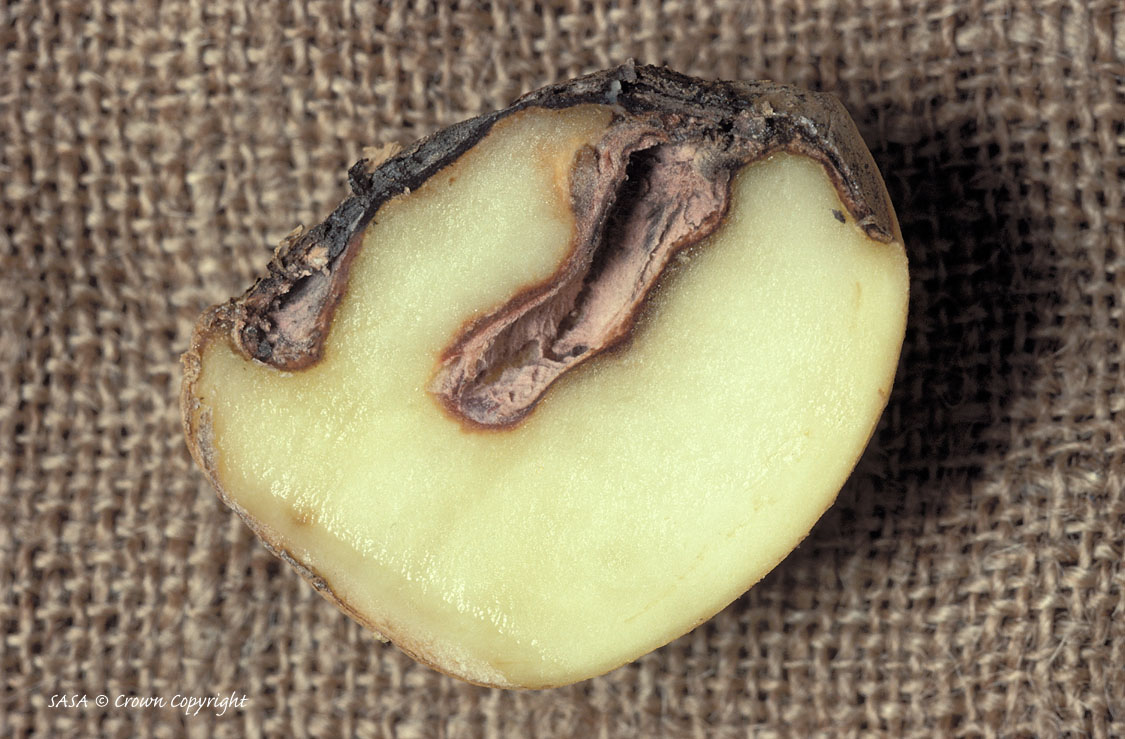
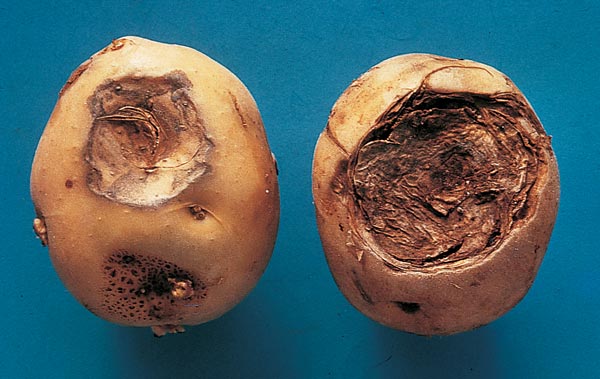
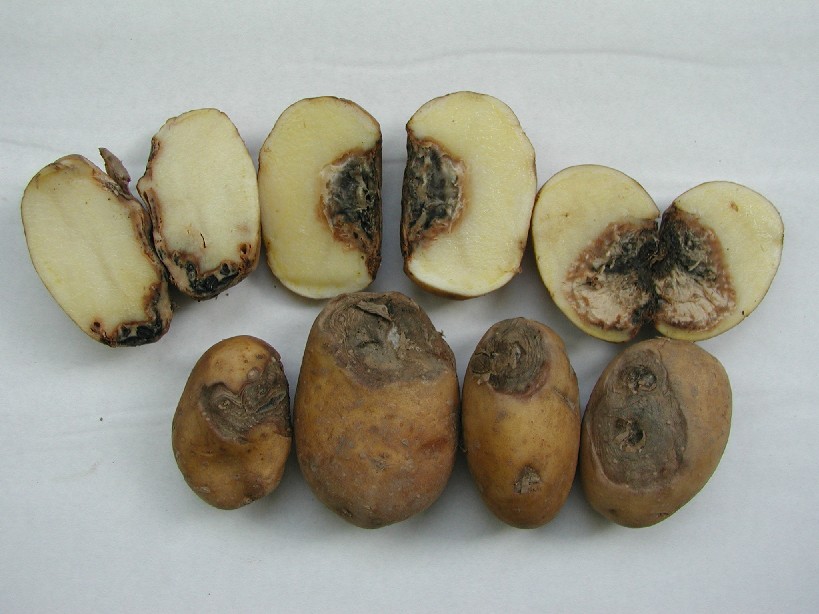 |
|
May be regulated without tolerance in some regions |
| Gangrène |
Phoma foveata
et autres Phoma spp. |
Tolérance définie (pourriture sèche) |
Observation visuelle des tubercules et identification sur milieu sélectif |
Tubercules: pourriture apparaissant en cours de conservation |
Dans certaines régions, ce parasite peut être réglementé sans tolérance |
| Фомоз |
Phoma foveata
и другие Phoma spp. |
Допуск для сухой гнили |
Визуальный осмотр клубней и выявление при отборе |
Клубень: гниение при хранении. Начальные поражения округлые, темные, слегка вдавленные, часто как от нажима пальцем. По мере развития становятся черными и впалыми с неровными волнистыми краями.
На поверхности может формироваться черная пикнидия. Сгнившая ткань обычно коричневая или черная с четкой границей между здоровой и пораженной тканью. Полости обычно покрыты фиолетовым, желтым или белым мицелиумом.
Ботва: невсхожесть или слабость растений |
В некоторых регионах регулируeтся без установления допуска |
 |
Leak
(watery wound rot) |
Pythium spp |
Tolerance for wet rot |
Visual observation of tubers and identification on specific medium |
Tuber: rots develop at wounds soon after harvest when growing conditions are hot. Tubers are discoloured with greasy feel. Rots develop in flesh of tuber with a clear dark line separating healthy outer tissue from spongy, soft brown diseased tissue which turns dark on exposure to air. |
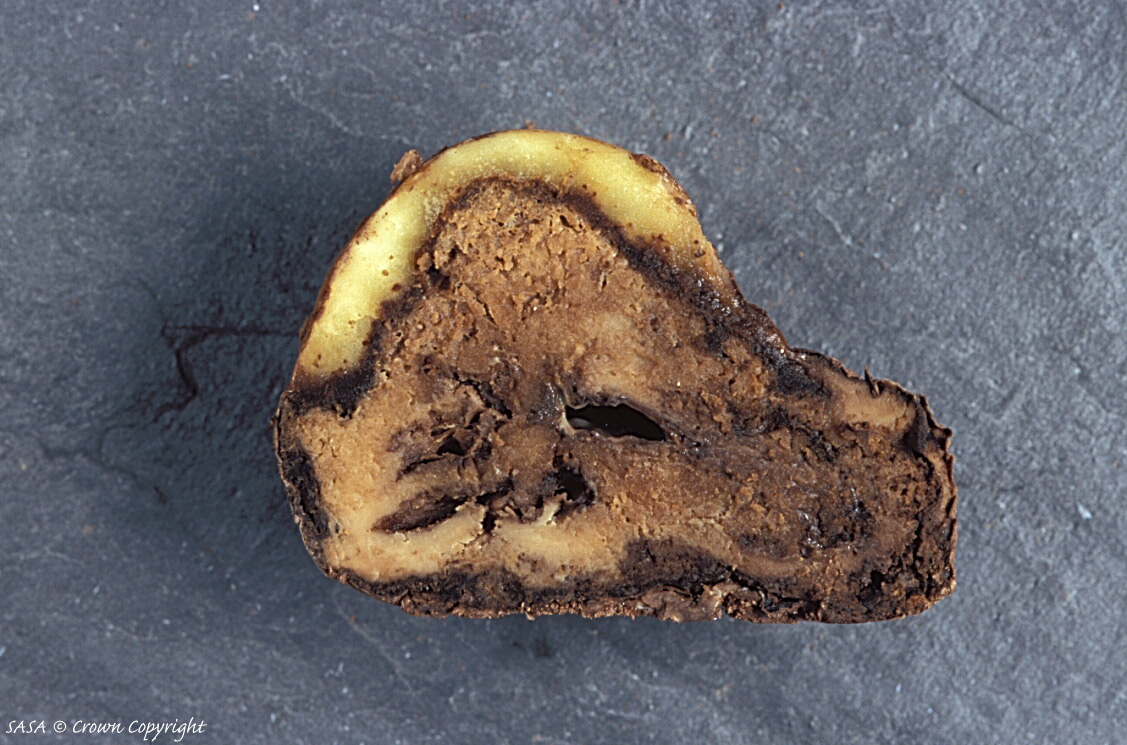 |
|
|
| Pourriture aqueuse |
Pythium spp |
Tolérance définie (pourriture humide) |
Observation visuelle des tubercules et identification sur milieu sélectif |
Tubercules: pourriture, apparaissant principalement peu après la récolte |
|
| Мокрая гниль |
Pythium spp |
Допуск для мокрой гнили |
Визуальный осмотр клубней и выявление при отборе |
Клубень: гниль возникает на повреждениях вскоре после сбора урожая, когда рост происходил при жаркой погоде. Клубни обесцвечиваются и становятся сальными на вид. Гниль развивается в ткани с четкой темной полосой между здоровой внешней и губчатой светло-коричневой пораженной тканью, темнеющей на свету. |
|
 |
| Pink rot |
Phytophthora erythroseptica |
Tolerance for wet rot |
Visual observation of tubers and identification on specific medium |
Tuber: rots develop at lenticels and eyes soon after harvest when conditions have been wet and warm just before harvest |
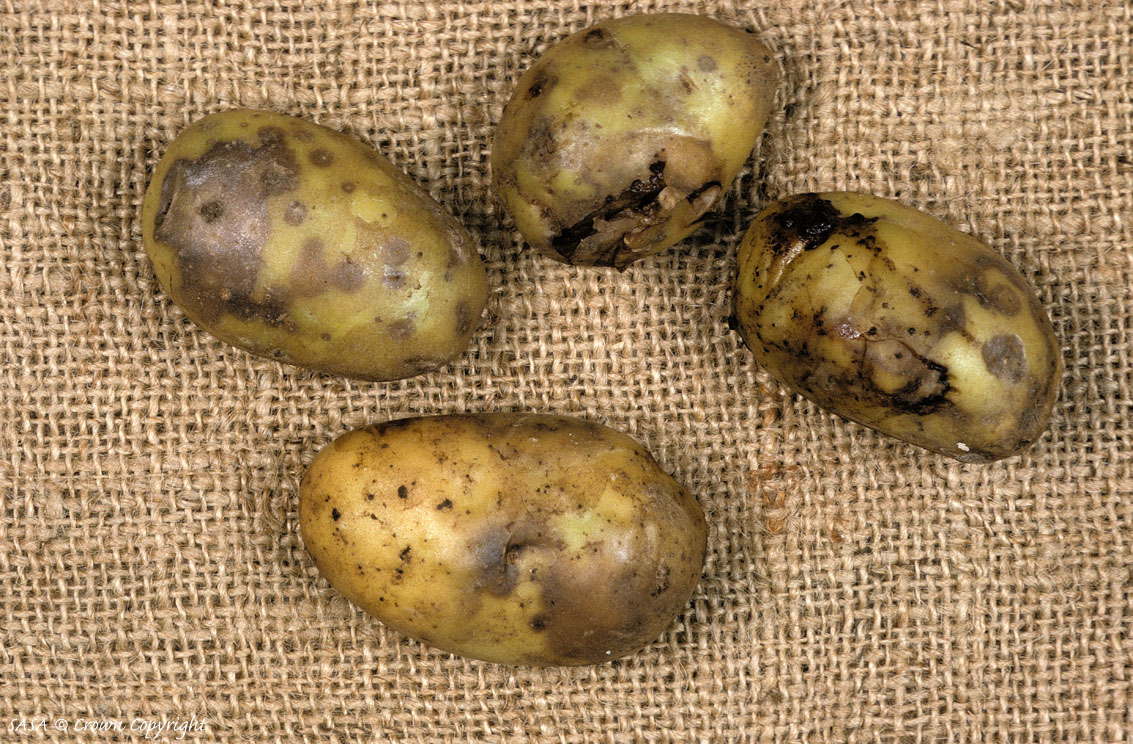
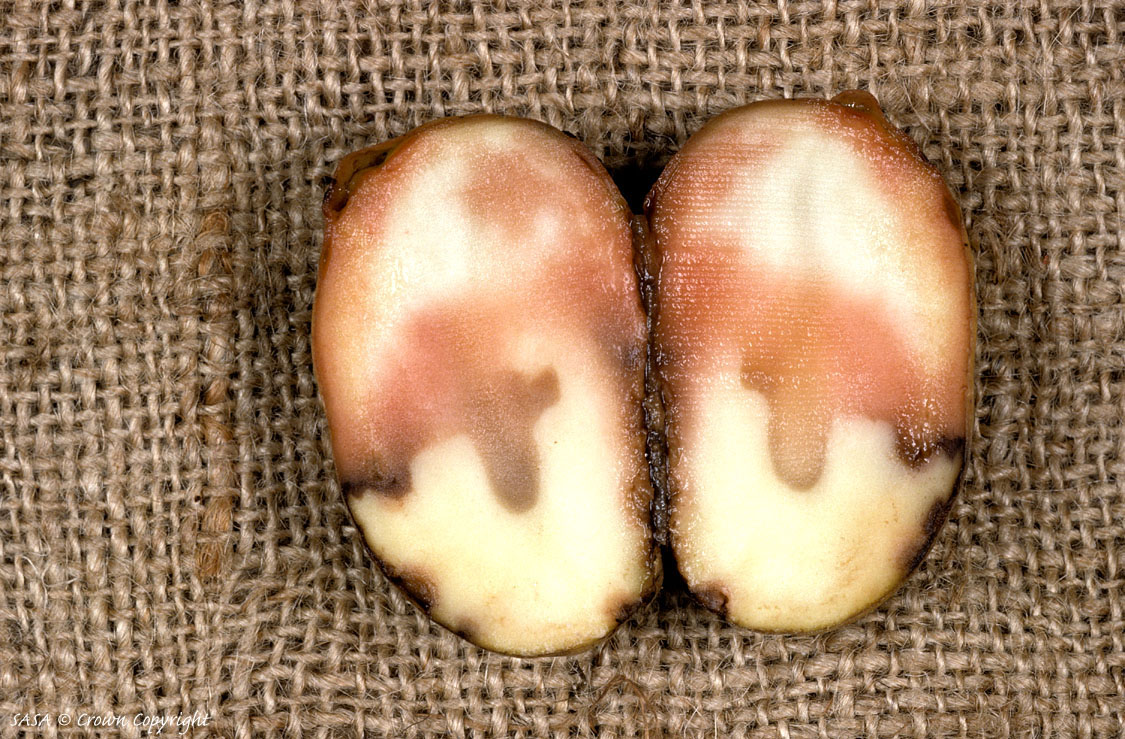
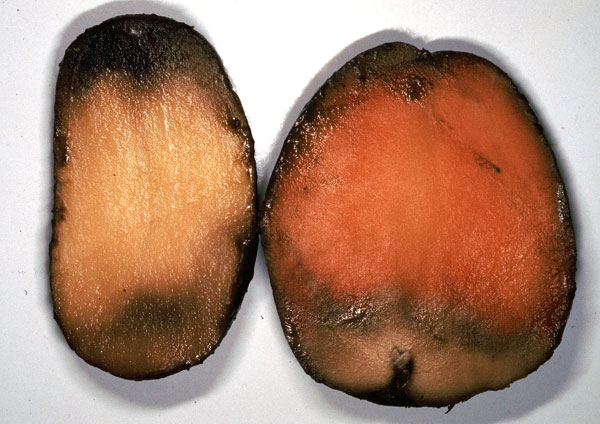 |
|
|
| Pourriture rose |
Phytophthora erythroseptica |
Tolérance définie (pourriture humide) |
Observation visuelle des tubercules et identification sur milieu sélectif |
Sur les tubercules: pourriture, apparaissant principalement peu après la récolte |
|
| Розовая гниль |
Phytophthora erythroseptica |
Допуск для мокрой гнили |
Визуальный осмотр клубней и выявление при отборе |
Клубень: гниль развивается у глазков вскоре после сбора урожая, когда погода перед сбором влажная и теплая |
|
 |
| Rubbery rot |
Goetrichum
candidum |
Tolerance for wet rot |
Visual observation of tubers and identification on specific medium |
Tuber: rot develops at or soon after harvest in tubers from waterlogged soils. Tuber surface is discoloured with patches of white mycelium developing on surface which feels damp. Internally, a grey, watery rot develops rapidly inwards from skin with a sour milk smell. |
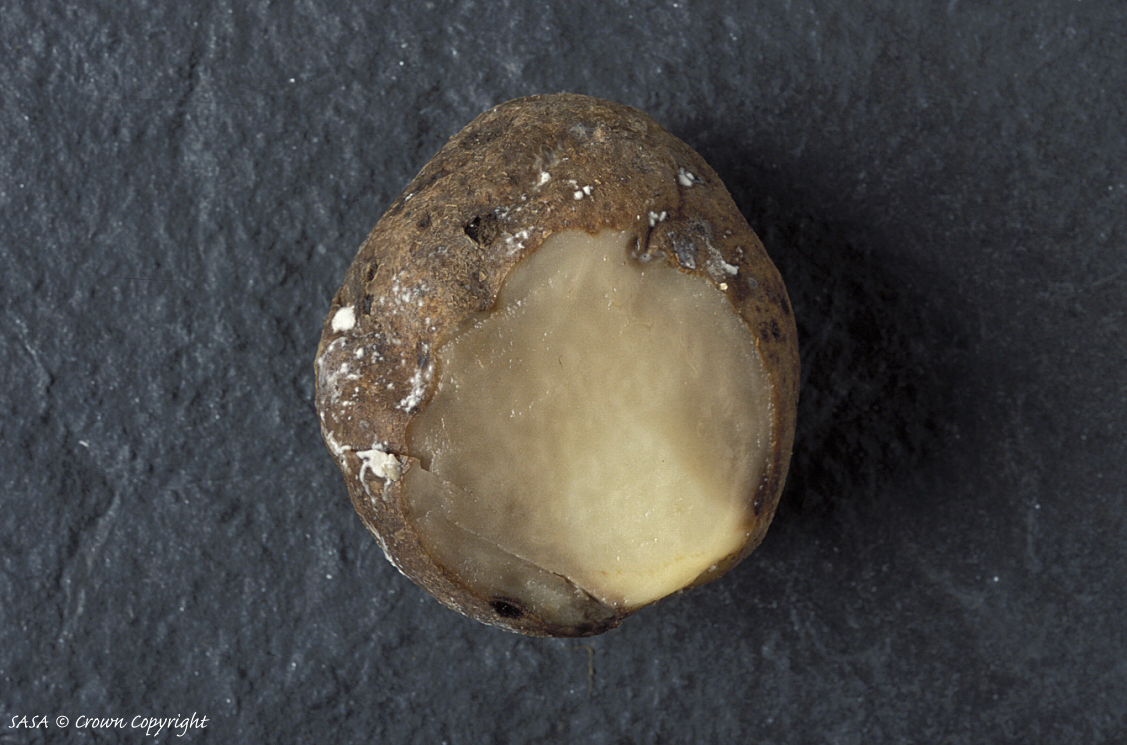 |
|
|
| Rubbery rot |
Goetrichum
candidum |
Tolérance définie (pourriture humide) |
Observation visuelle des tubercules et identification sur milieu sélectif |
Tubercules: pourriture apparaissant en cours de conservation |
|
| "Резиновая" гниль |
Goetrichum
candidum |
Допуск для мокрой гнили |
Визуальный осмотр клубней и выявление при отборе |
Клубень: гниение развивается при или сразу после уборки во влажных почвах. Влажная поверхность клубня покрывается белыми пятнами мицелиума.
Водянистая серого цвета гниль с запахом кислого молока быстро распространяется внутрь |
|
 |
Rhizoctonia
Black scurf (on tuber) /
Stem canker
(on the plant) |
Perfect state: Corticium;
imperfect state: Rhizoctonia solani |
Tolerance on tubers (black scurf) |
Visual observation of plants and tubers |
Tuber: blemish caused by dark brown or black sclerotia forming on tuber surface; coverage may be difficult to assess accurately on unwashed dirty tubers.
Plant: uneven emergence, wilting and stunting.
Stem canker: brown slightly sunken, sharp-edged lesions develop on stem bases.
A superficial white powdery collar of fungal growth may be seen on stems just above soil level. |
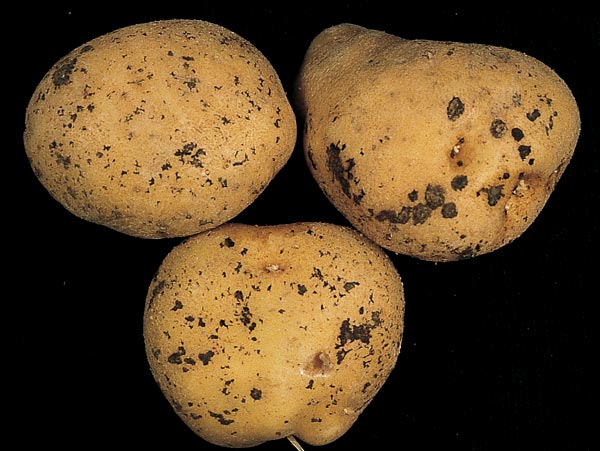 |
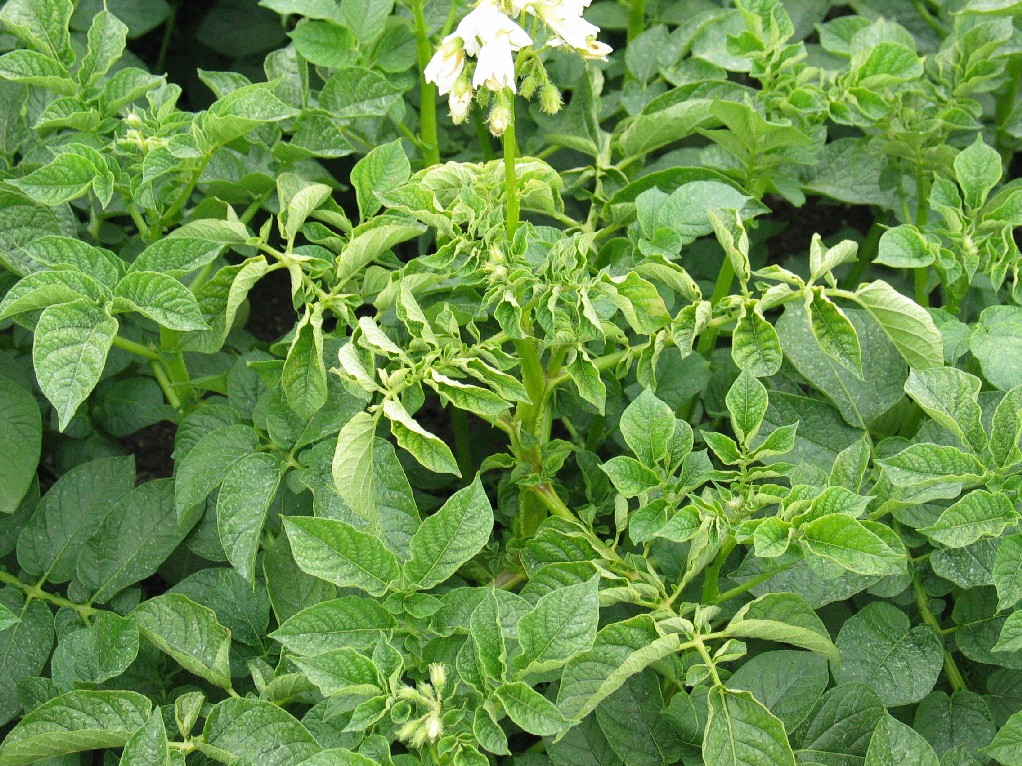
 |
Stem canker regulated in some regions. No need for general regulation because regulation of black scurf is seen as more effective |
| Rhizoctone brun aussi appelé rhizoctone noir |
Forme parfaite: Thanatephorus; Forme imparfaite: Rhizoctonia solani |
Tolérance définie en ce qui concerne les tubercules |
Observation visuelle des plantes et des tubercules |
Tubercules: taches noires superficielles (sclérotes), entailles ou crevasses, bouchons liégeur (dry core), tubercules aériens
Plante: levée irrégulière, flétrissement et rabougrissement |
Le rhizoctone brun affectant la plante est réglementé dans certaines régions.
Il n’est pas nécessaire de généraliser cette réglementation parce que la réglementation du rhizoctone brun affectant les tubercules est jugée plus efficace |
Парша черная (на клубне)/
ризоктониоз
(на растении) |
Совершенная
стадия: Corticium; несовершенная
стадия: Rhizoctonia solani |
Допуск для клубней (черная парша) |
Визуальный осмотр растений и клубней |
Клубень: темно-коричневые или черные склеротические пятна на кожуре; трудно оценить площадь поврежденной поверхности немытых клубней
Ботва: неравномерная всхожесть, увядание и чахлость
Ризоктониоз: коричневые впалые повреждения с острыми краями развиваются в основании корня. Непосредственно над поверхностью земли стебель может быть опоясан налетом грибковой плесени |
Ризоктониоз регламентируется в некоторых
регионах. Необходимости для повсеместного регламентирования нет, т.к. регламентирование парши
черной считается более эффективным |
 |
| Silver scurf |
Helminthosporium solani |
Controlled indirectly through tolerance for shrivelled tubers |
Visual observation of tubers and identification on specific medium |
Tuber: skin blemish. Disease starts as small, round, silvery patches on skin. In humid conditions, dark sooty conidiophores can develop around the edge of lesions. Large silvery patches develop as individual lesions expand and merge during storage. |
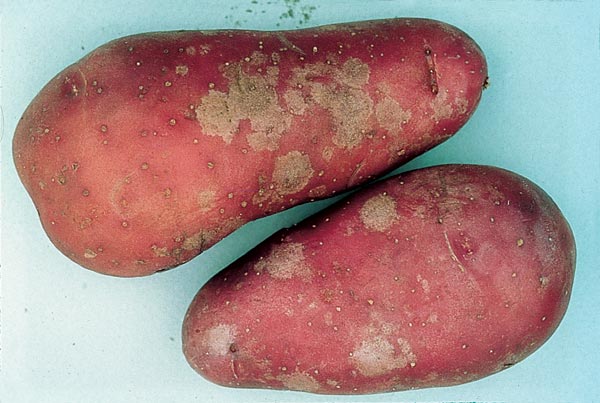
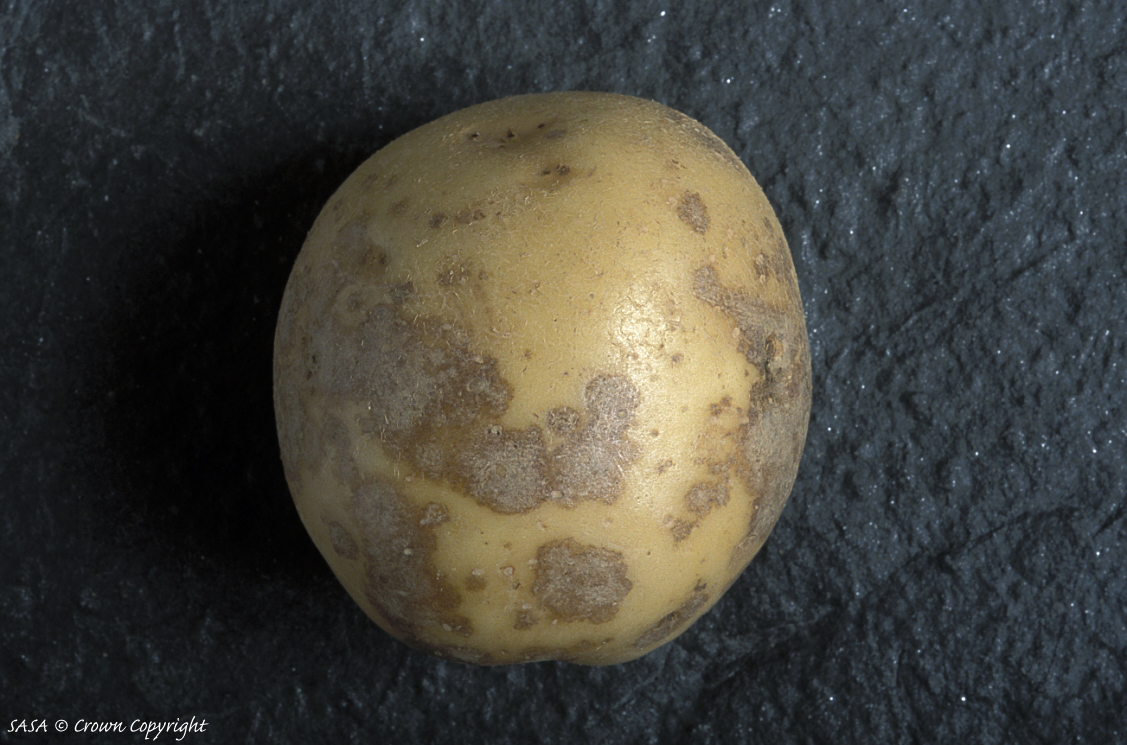
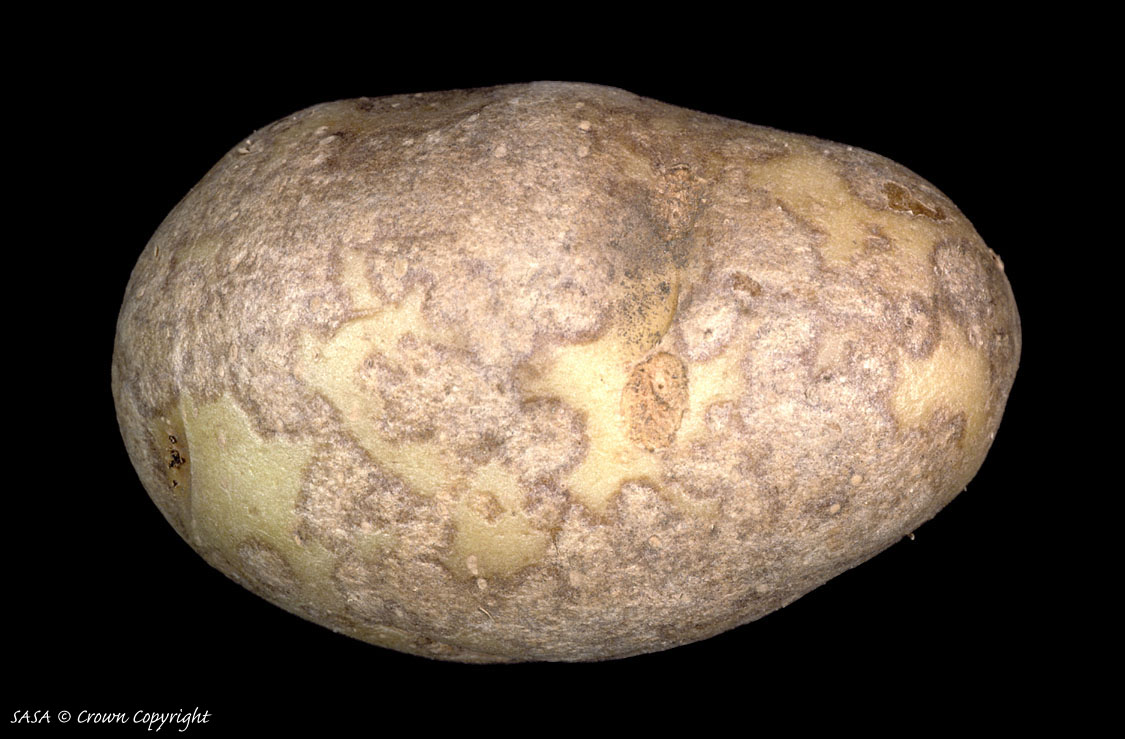 |
|
Regulated with tolerance in some regions |
| Gale argentée |
Helminthosporium solani |
Réglementé indirectement en définissant une tolérance pour les tubercules ratatinés |
Observation visuelle des tubercules et identification sur milieu sélectif |
Tubercules: taches argentées de forme irrégulière sur l’épiderme |
Réglementé, avec une tolérance, dans certaines régions |
| Парша серебристая |
Helminthosporium solani |
Косвенно регулируется допуском на сморщенность клубней |
Визуальный осмотр клубней и выявление при отборе |
Клубень: пятна на кожуре. Болезнь начинается с маленьких круглых серебристых пятен на кожуре. Во влажных условиях по краям пятен может появиться сажный налет. Во время хранения, по мере роста отдельных пятен, могут образовываться большие серебристые участки пораженной поверхности |
В некоторых регионах регулируется допуском |
 |
| Black dot |
Colletotrichum coccodes |
Controlled indirectly through tolerance for shrivelled tubers |
Visual observation of tubers and identification on specific medium |
Tuber: skin blemish. Silvery, irregularly shaped lesions present at harvest quickly darken. Lesion is less well defined than silver scurf. Oval, pinhead black bodies (microsclerotia) are often visible on the skin.
Growing plant: may contribute to early dying disease in warm climates |
 |
|
Regulated with tolerance in some regions |
| Dartrose |
Colletotrichum coccodes |
Réglementé indirectement en définissant une tolérance pour les tubercules ratatinés |
Observation visuelle des tubercules et identification sur milieu sélectif |
Tubercules: taches sur la peau
Croissance de la plante: peut favoriser une destruction précoce en climat chaud |
Réglementé, avec une tolérance, dans certaines régions |
| Антрокноз |
Colletotrichum coccodes |
Подвергается косвенному регламентирова-нию путем установления предельного допустимого количества сморщенных клубней |
Визуальный осмотр клубней и выявление при отборе |
Клубень: пятна на кожуре. Серебристые повреждения неправильной формы, видимые при уборке, быстро темнеют. Повреждения менее выражены, чем при серебристой парше. Черные овальные образования часто видны на кожуре.
Ботва в вегетационный период: может способствовать раннему появлению болезни, ведущей к гибели растения в условиях теплого климата |
В некоторых регионах регулируется допуском |
 |
| Skin spot |
Polyscytalum pustulans |
Not regulated |
Visual observation of tubers |
Tuber: skin blemish and death of eyes. Small (1-2 mm), brown-black pimples develop on the skin, usually 2-3 months after harvest, eyes may be killed
Plant: uneven and non-emergence |
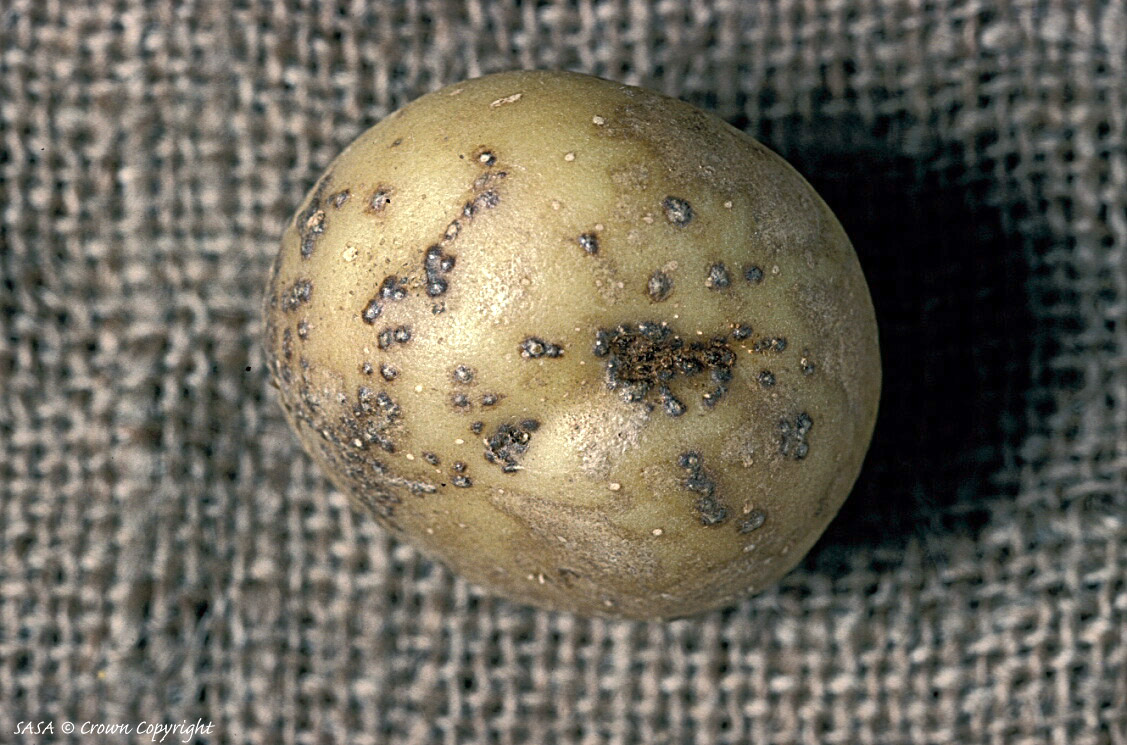 |
|
Regulated with tolerances in some regions. No need for a general regulation, not a barrier to trade |
| Oosporiose |
Polyscytalum pustulans |
Parasite non réglementé |
Observation visuelle des tubercules |
Tubercules: taches sur la peau et destruction des yeux du tubercule
Plante: levée irrégulière ou non levée |
Dans certaines régions, ce parasite est réglementé avec une tolérance. Il n’est pas nécessaire d’établir une réglementation générale; il ne constitue pas un obstacle au commerce |
| Ооспороз (парша
бугорчатая) |
Polyscytalum pustulans |
Не регулируется |
Визуальный осмотр клубней |
Клубень: пятна на кожуре и отмирание глазков. Небольшие (1-2 мм) коричнево-черные наросты образуются на кожуре, обычно 2-3 месяца после уборки.
Ботва: неравномерный
рост и невсхожесть |
В некоторых регионах регулируется допуском. Нет необходимости в повсеместном
регулировании, не является препятствием для торговли |
 |
| Early blight |
Alternaria solani and Alternaria alternata |
Controlled indirectly through tolerances for dry rot |
Visual observation of leaves and tubers |
Tuber: largely superficial rot
Plant: necrosis of leaves |
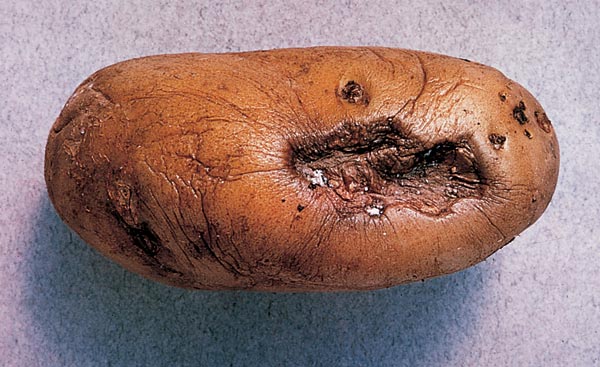 |
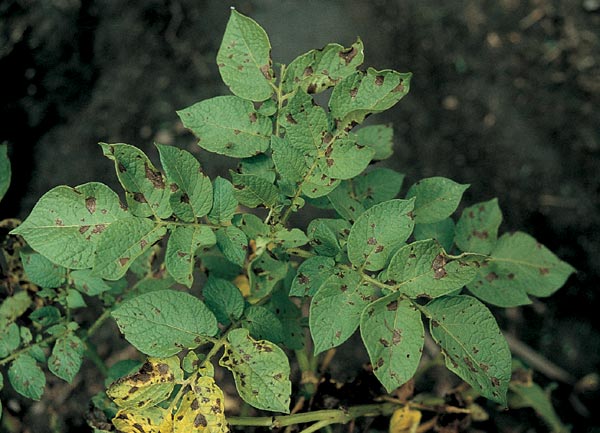 |
|
| Alternariose de la pomme de terre |
Alternaria solani et Alternaria alternata |
Parasite réglementé indirectement par le biais de la réglementation de la pourriture sèche |
Observation visuelle des feuilles et des tubercules |
Tubercules: pourriture essentiellement superficielle
Plante: nécroses brunes à noires sur le feuillage, présence d'anneaux concentriques sur les plus grosses taches |
|
| Альтернария (черная плесень) |
Alternaria solani и Alternaria alternata |
Косвенно регулируется допуском для сухой гнили |
Визуальный осмотр листьев и клубней |
Клубень: преимущественно поверхностная гниль
Ботва: некроз листьев |
|
 |
| White mould |
Sclerotinia sclerotiorum |
Controlled through tolerance for dry rot |
Visual observation of stem |
Tuber: rot at heel end, rare. Internal rot is pale brown with fluffy white mycelia and black sclerotia developing in cavities.
Plant: wilting and death of individual stems. Pale green to white, water-soaked lesions develop at base of stem, reddish brown zones develop on these lesions accompanied by growth of woolly, white mycelia in humid conditions. |
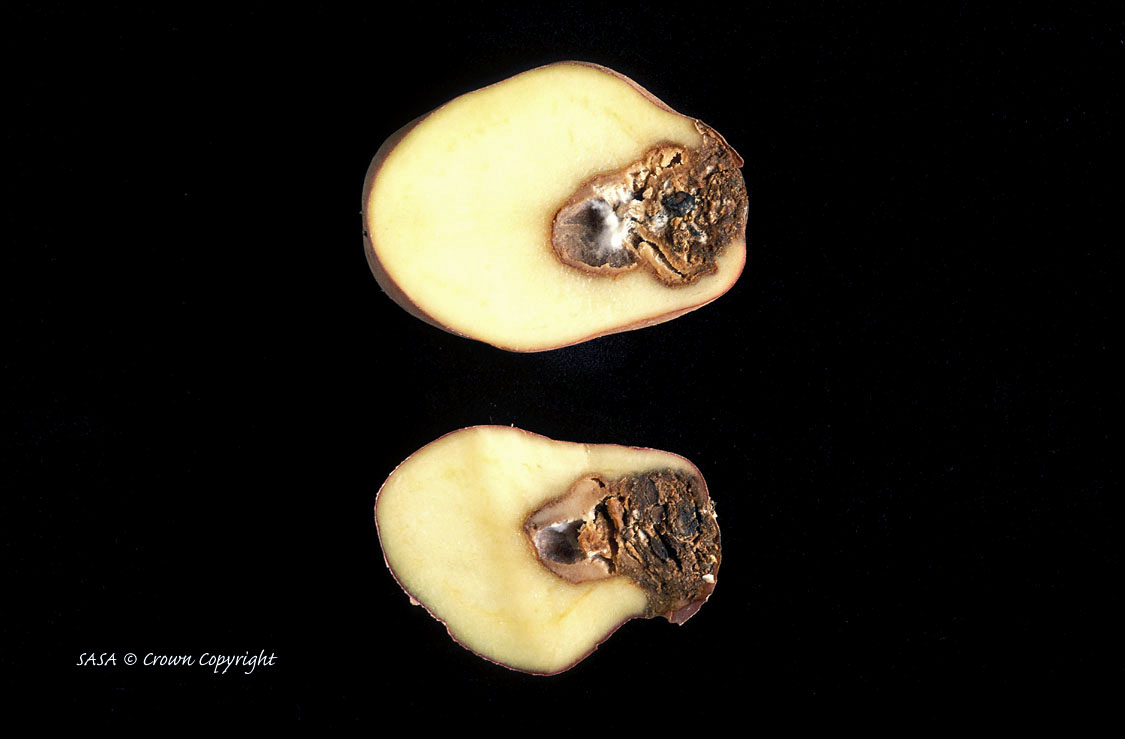 |
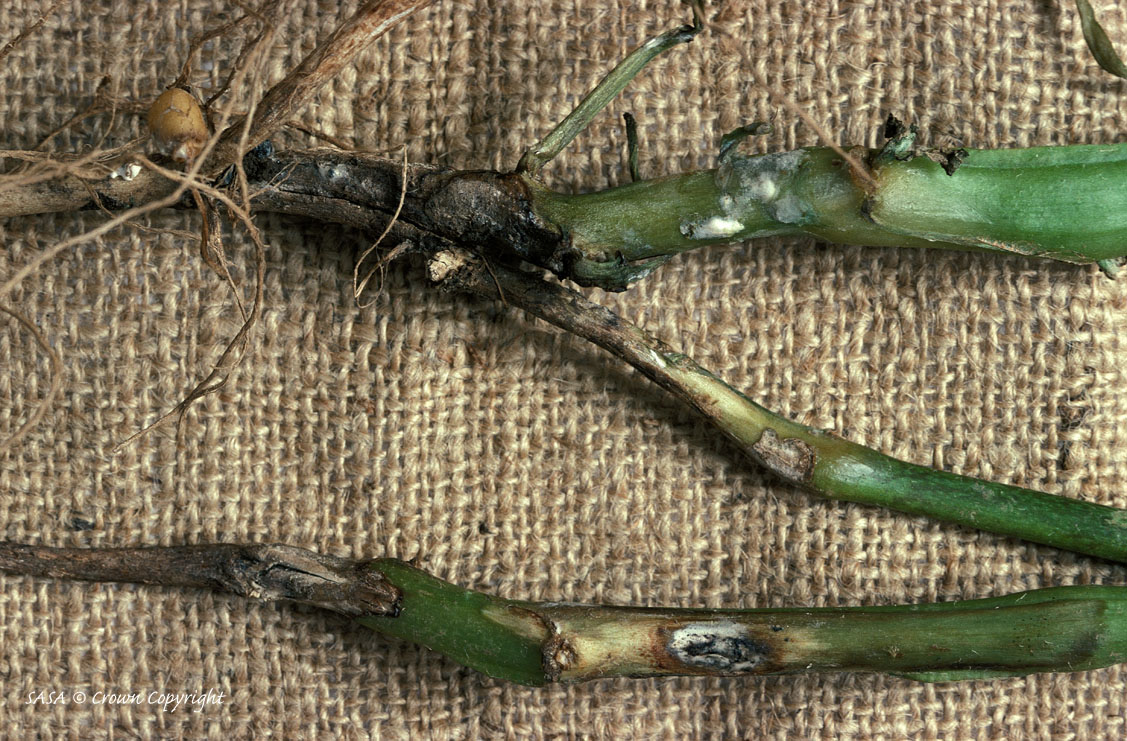
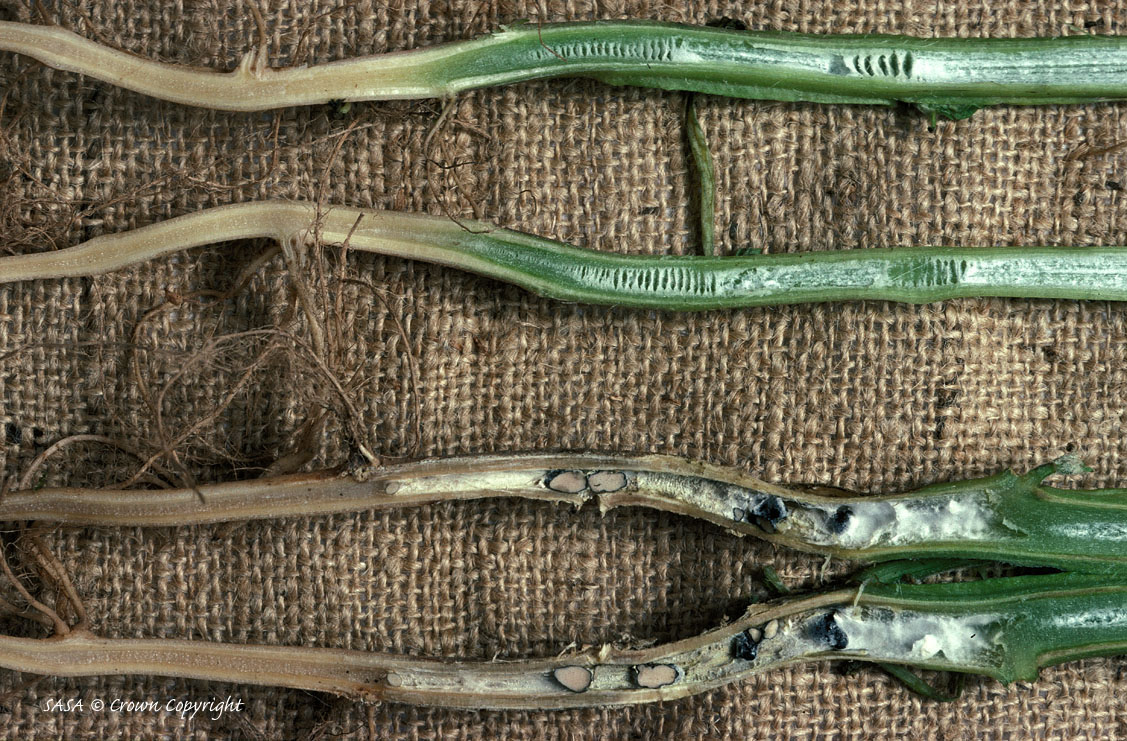
 |
Not to be regulated. Infection is from soil inoculum and not from the tuber |
| Sclerotiniose |
Sclerotinia sclerotiorum |
Parasite réglementé par le biais de la réglementation de la pourriture sèche |
Observation visuelle de la tige |
Tubercules: pourriture, rare
Plante: flétrissement et mort de certaines tiges |
Ce parasite ne doit pas être réglementé. L’infection provient du sol et non pas du tubercule |
Склеротиния
(белая гниль) |
Sclerotinia sclerotiorum |
Регулируется допуском для сухой гнили |
Визуальный осмотр стеблей |
Клубень: гниль, встречается редко. Внутренняя гниль светло-коричневая с белым мицелиумом и черными склеротическими образованиями в полостях.
В основании стеблей образуются водянистые поражения, от бледно-зеленых до белых, на которых появляются красновато-коричневые зоны с возможным ростом ворсистого
белого мицелиума во влажных условиях
Ботва: увядание и отмирание отдельных стеблей |
Не подлежит регулированию. Инфекция передается через почву, а не клубнями |
 |
| Powdery scab |
Spongospora subterranea |
Tolerance |
Visual observation of tubers with confirmation by microscope |
Tuber: round individual raised scabs present on tubers at harvest,
lesions erupt exposing brown powdery tissue (sporeballs) leaving tattered fragments of skin along
edge of lesion. Infection at time of eye development can result in outgrowths (cankers) of varying
sizes developing at rose end of tubers.
Powdery scab spore balls at 250 times magnification. |
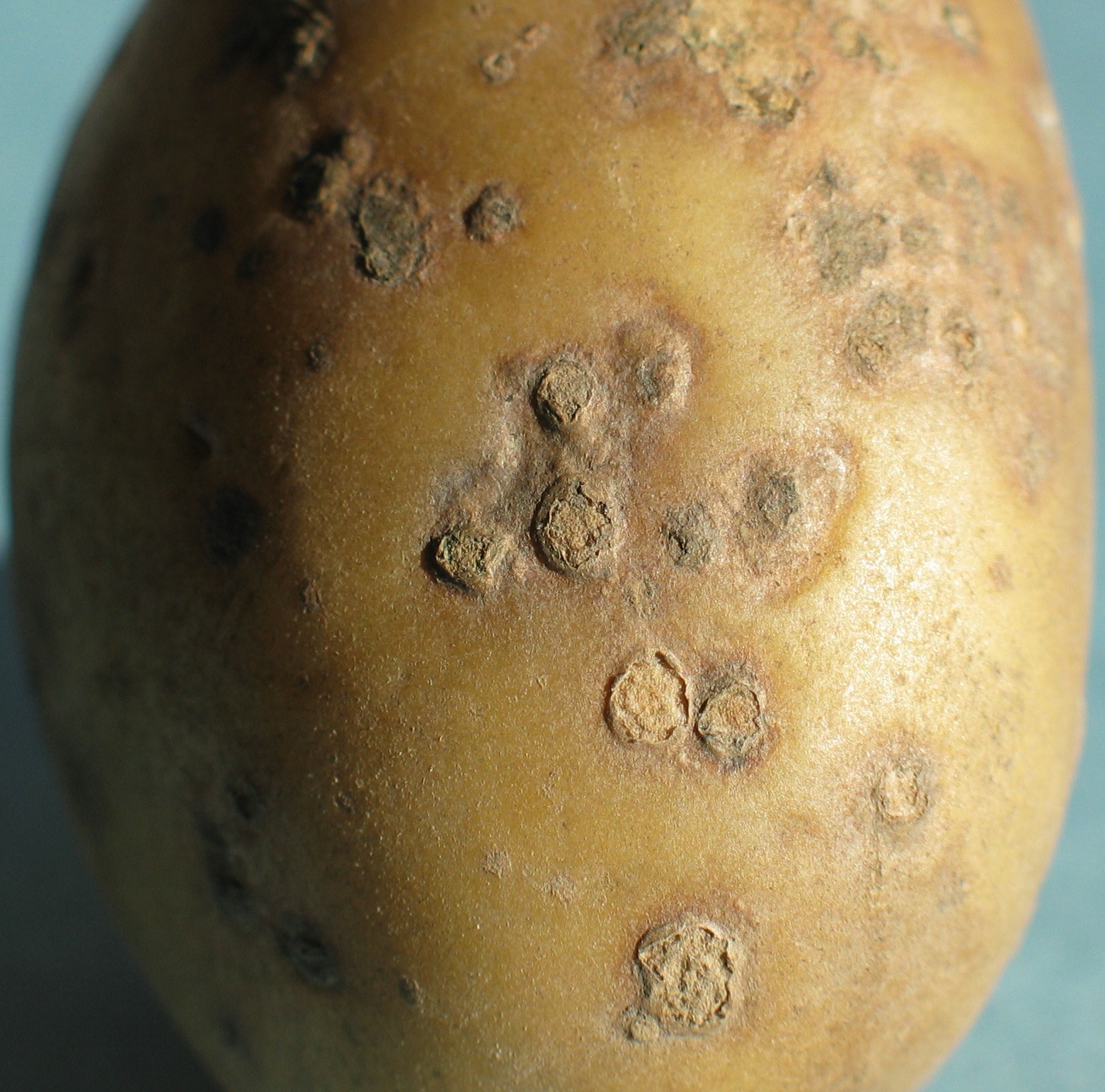
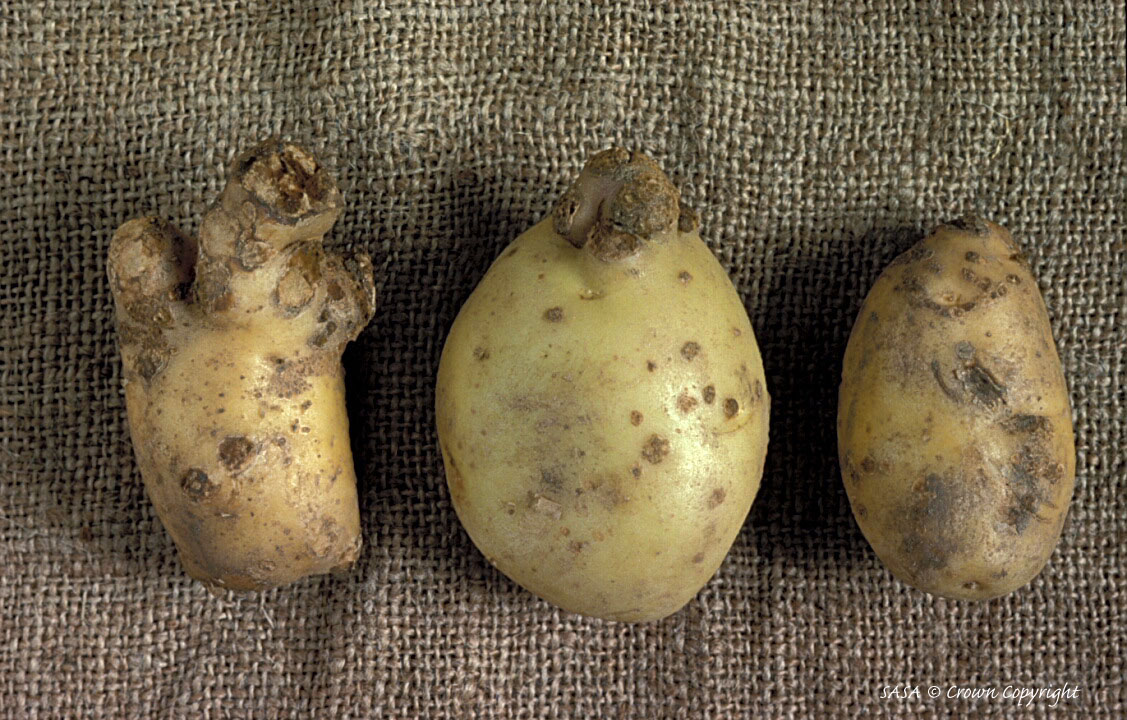
 |
|
May be regulated with tolerance in some regions |
| Gale poudreuse |
Spongospora subterranea |
Tolérance définie |
Observation visuelle des tubercules avec confirmation au microscope |
Tubercules: formation de pustules et de chancres |
Ce parasite peut être réglementé, avec une tolérance, dans certaines régions |
| Парша порошистая |
Spongospora subterranea |
Допуск |
Визуальный осмотр клубней и подтверждение анализом под микроскопом |
Клубень: при уборке - круглые возвышающиеся бляшки, которые, лопаясь, высвобождают коричневую пудрообразную ткань (споры).¨
Поражение в период развития глазков может вызывать наросты (язвы).
Споры парши порошистой при 250-кратном увеличении |
В некоторых регионах может регулироваться допуском |
 |
| Verticillium wilt |
Verticillium dalhiae and V. alboatrum |
Not regulated |
Visual observation of leaves and plant |
Tuber: vascular discolouration
Plant: wilting and death |
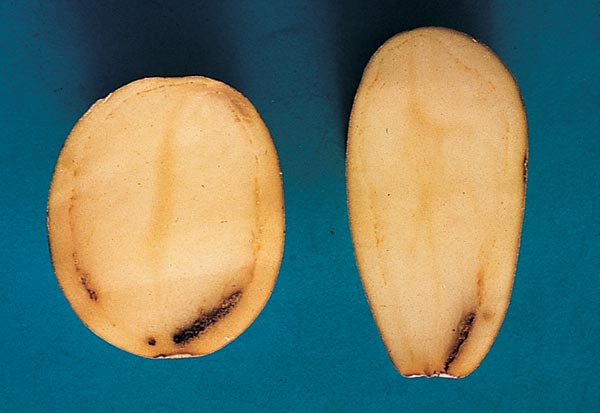 |
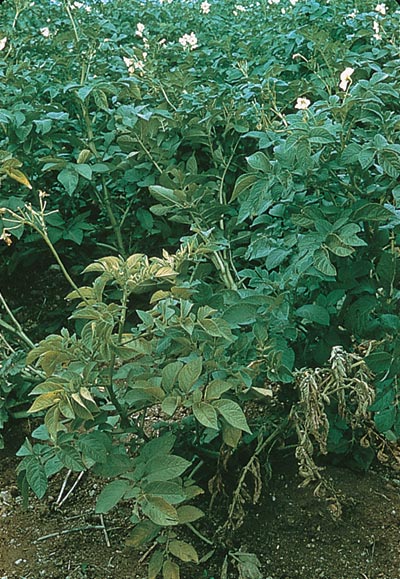 |
No need for regulation in UNECE standard because path of infection is primarily though infested soil and not the seed tuber. |
| Verticilliose |
Verticillium dalhiae et V. alboatrum |
Parasite non réglementé |
Observation visuelle des feuilles et de la plante |
Tubercules: décoloration vasculaire
Plante: flétrissement et mort de la plante |
Il n’est pas nécessaire de réglementer ce parasite dans la norme parce que la voie de contamination est principalement le sol infecté et non pas le tubercule |
Вертициллез
(вертициллезное увядание) |
Verticillium dalhiae и V. alboatrum |
Не регулируется |
Визуальный осмотр листьев и растения |
Клубень: обесцвечивание сосудов
Ботва: увядание и отмирание |
Нет необходимости регулировать в стандарте, т.к. распространяется через почву, а не клубнями |
| VIRUS VIRUS ВИРУСЫ |
| Severe mosaic |
Potato viruses Y (all strains), A, V and M, and in combination with PVX and S |
Tolerance for severe virus |
Visual observation of plant and ELISA test |
Plant: distortion or deformation of leaves or plants. This can be rugosity, crinkle, rolling and rigidity of the leaves. Mottling of leaflets may also occur.
Tuber: superficial necrosis caused only by PVY strains |
 |
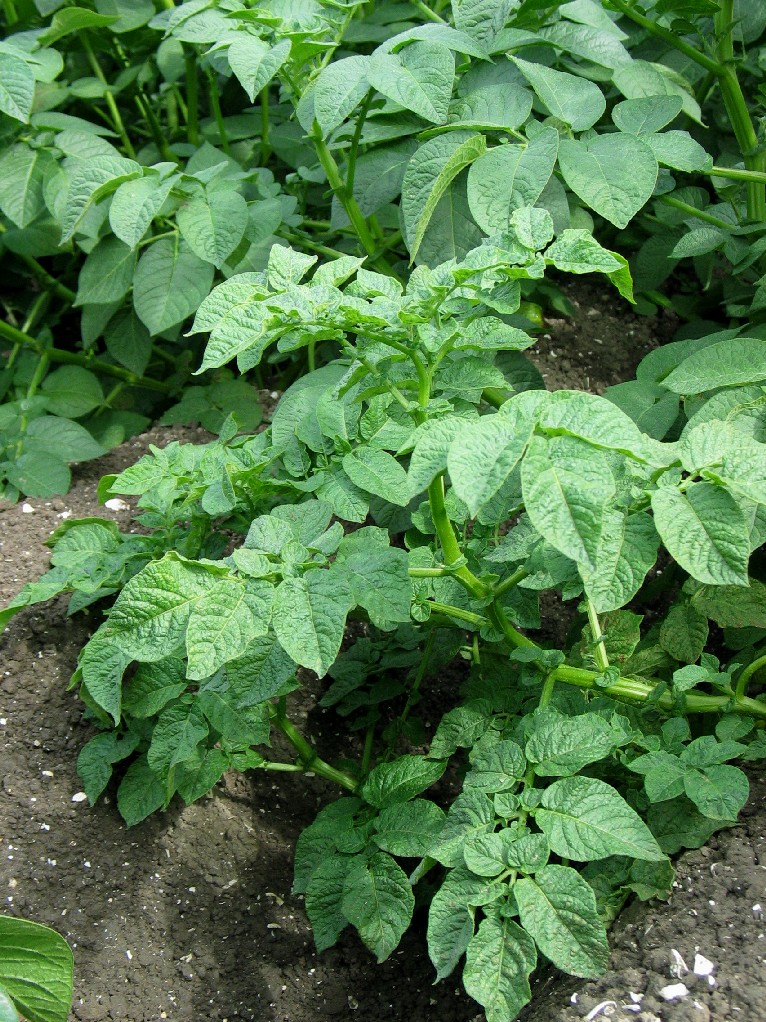
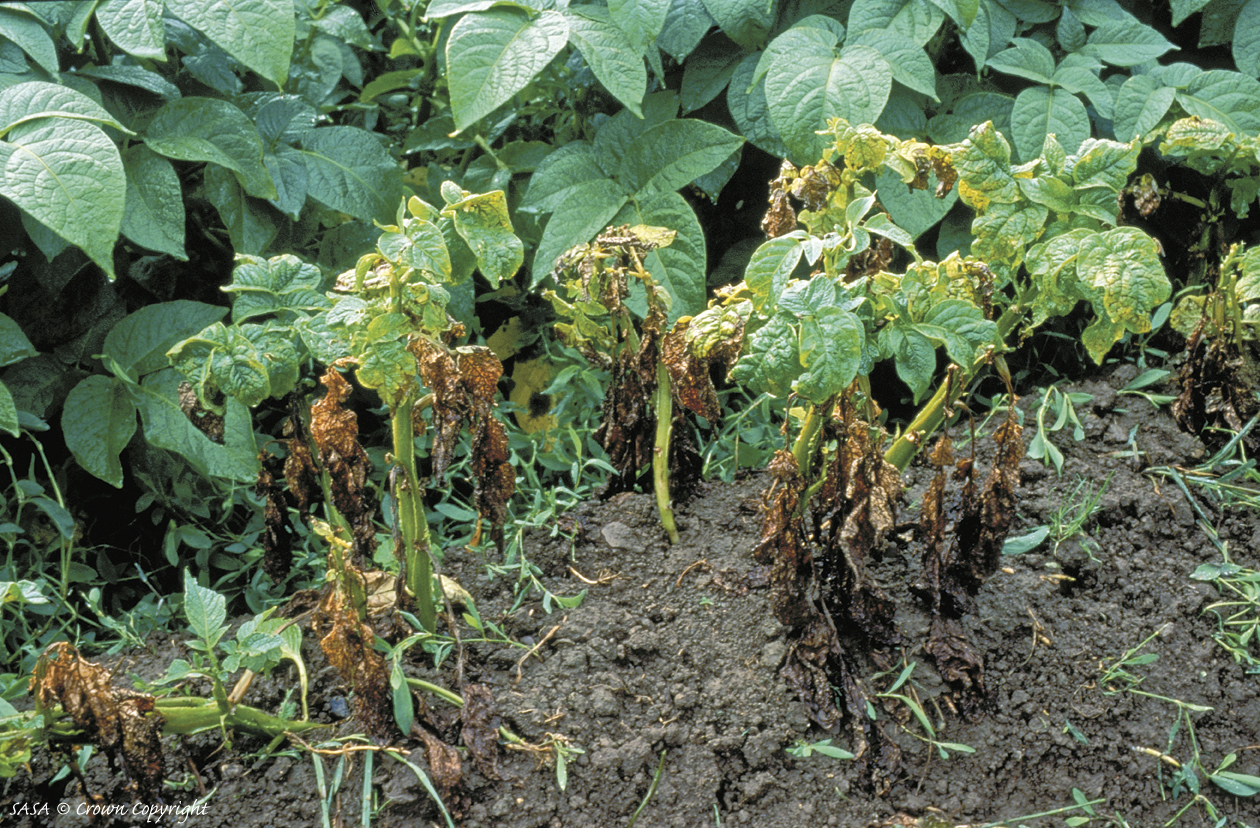
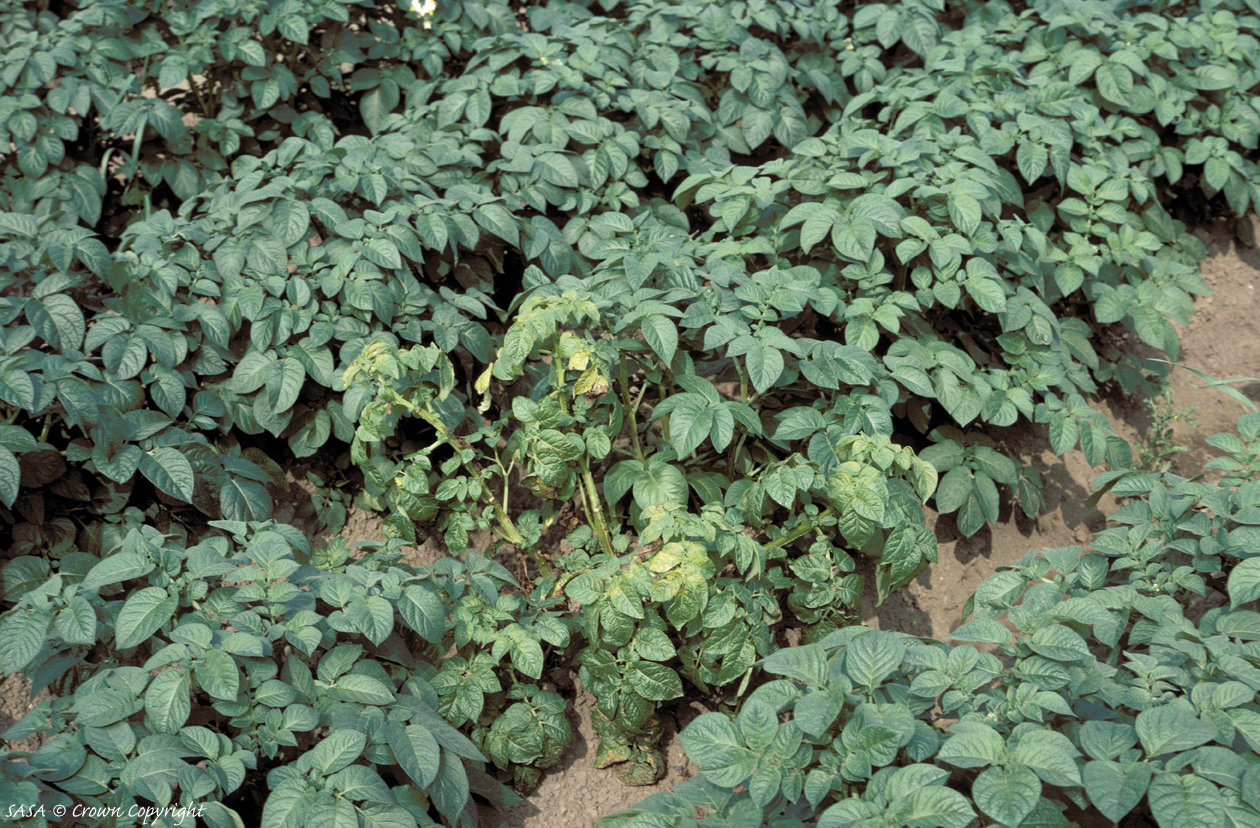
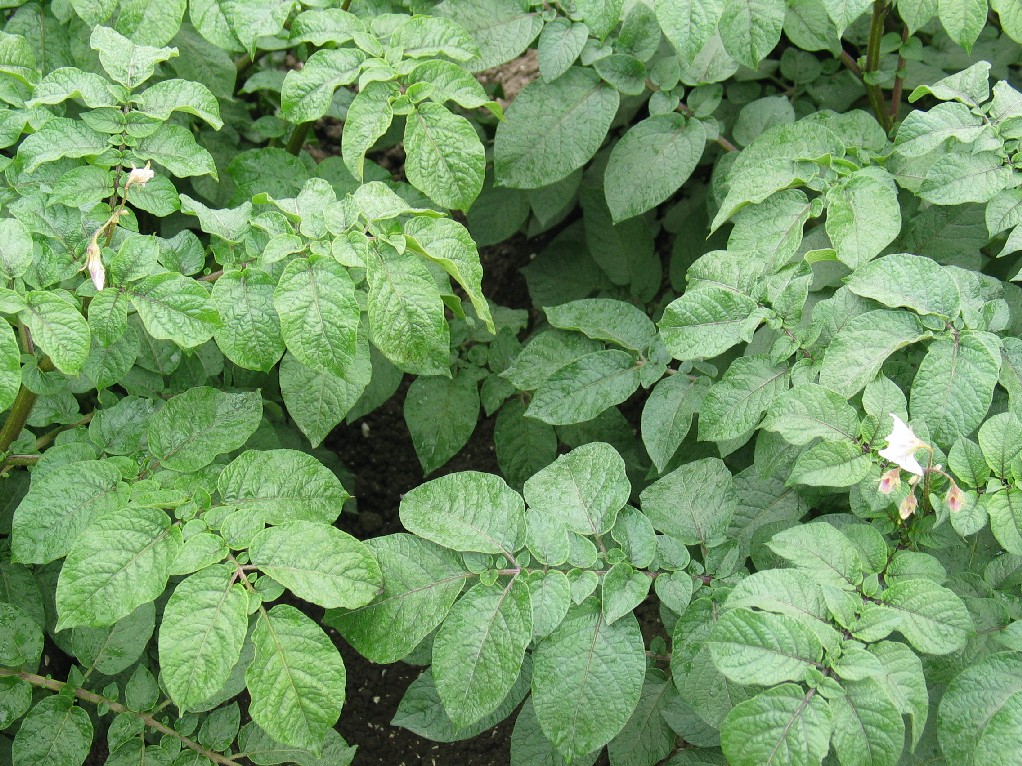
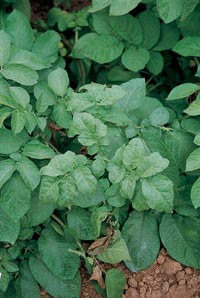 |
Tuber symptoms, regulated with tolerance in some regions |
| Virose grave |
Virus de la pomme de terre Y (toutes souches), A, V et M, associés ou non à PVX et S |
Virus réglementé avec tolérance définie (virus grave) |
Observation visuelle de la plante et test ELISA |
Plante: présence ou non d’une décoloration des feuilles.
Déformation qui peut prendre la forme d’une rugosité, d’une frisolée, d’un enroulement
ou d’une rigidité des feuilles ou encore d’un nanisme de la plante
Tubercules: nécrose superficielle causée uniquement par la souche PVY |
Symptômes au niveau des tubercules. Dans certaines régions, ce parasite est réglementé, avec une tolérance |
| Мозаика острая |
Картофельные штаммы Y (все линии), A, V и M и в сочетании с вирусами PVX и S |
Допуск для cильного вируса |
Визуальный осмотр растения и тест ELISA |
Ботва: деформирование листьев или растений: морщинистость, скрученность и жесткость листьев. Возможна крапчатость листьев
Клубень: поверхностный некроз возникает только при поражении штаммами PVY |
Симтомы на клубнях; в некоторых регионах регулируется допуском |
 |
| Mild mosaic |
PVX, PVS and PVY strains, especially PVYN |
Tolerance for mild mosaic |
Visual observation of plant and ELISA test |
Plant: discolouration or mottle of leaves without distortion
Tuber: superficial necrosis caused only by PVY strains |
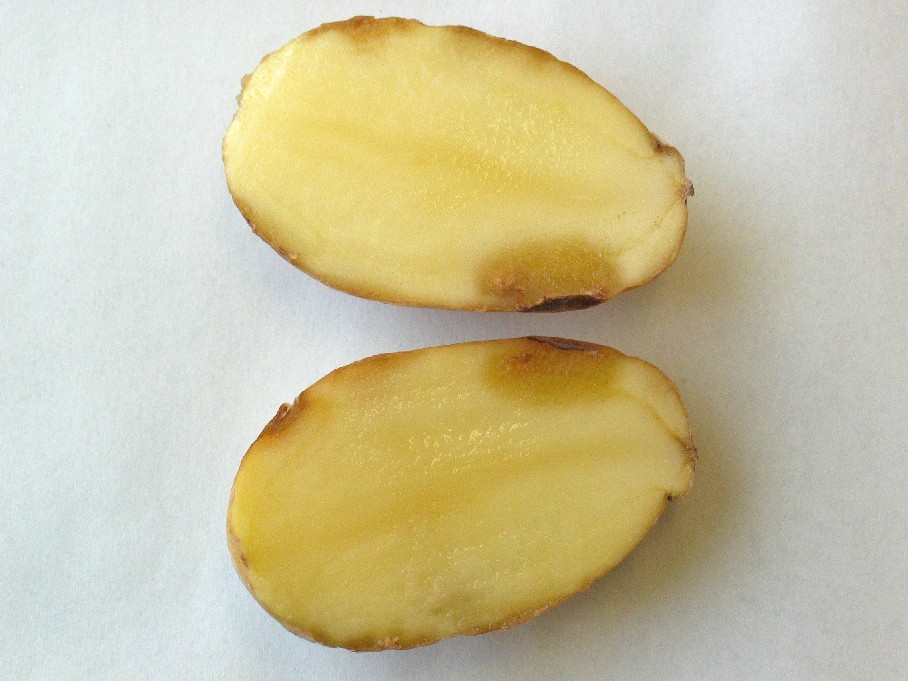 |
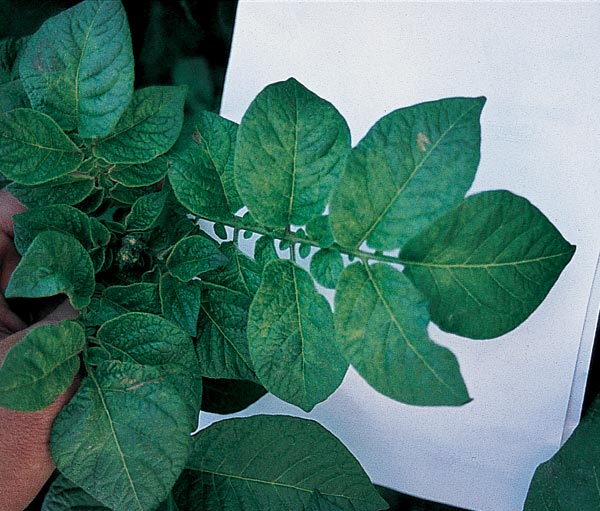
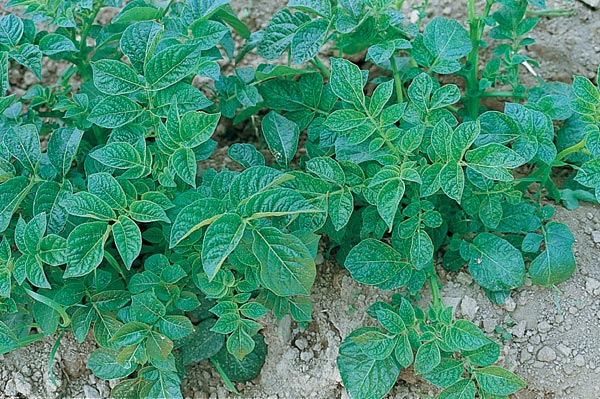
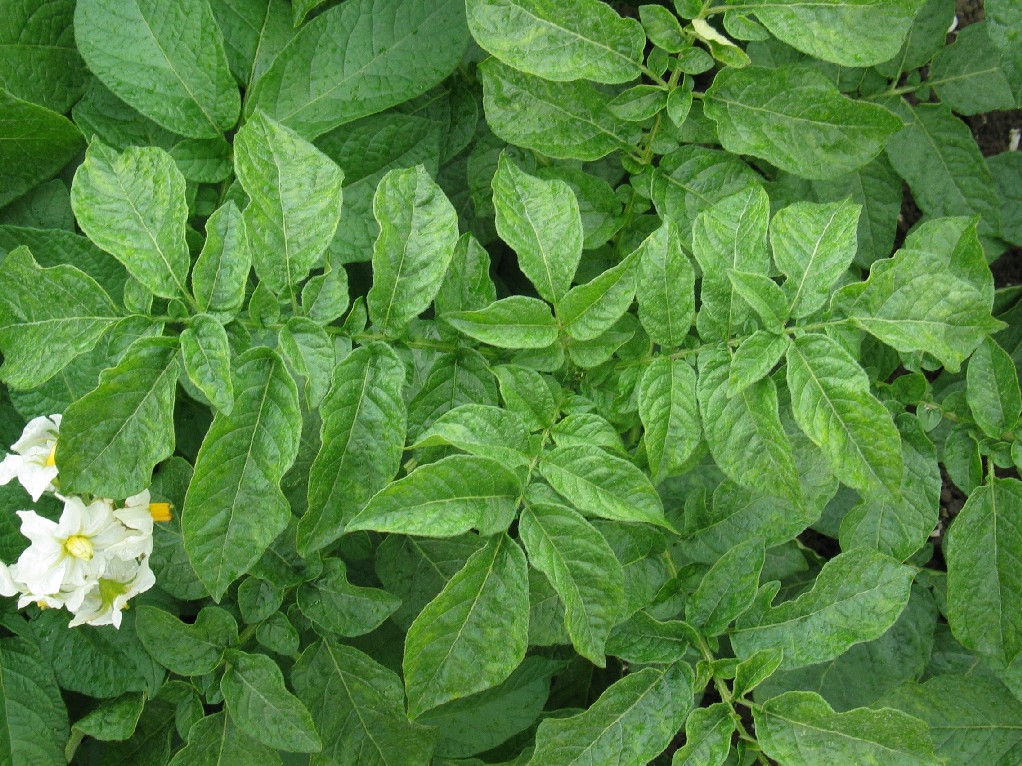
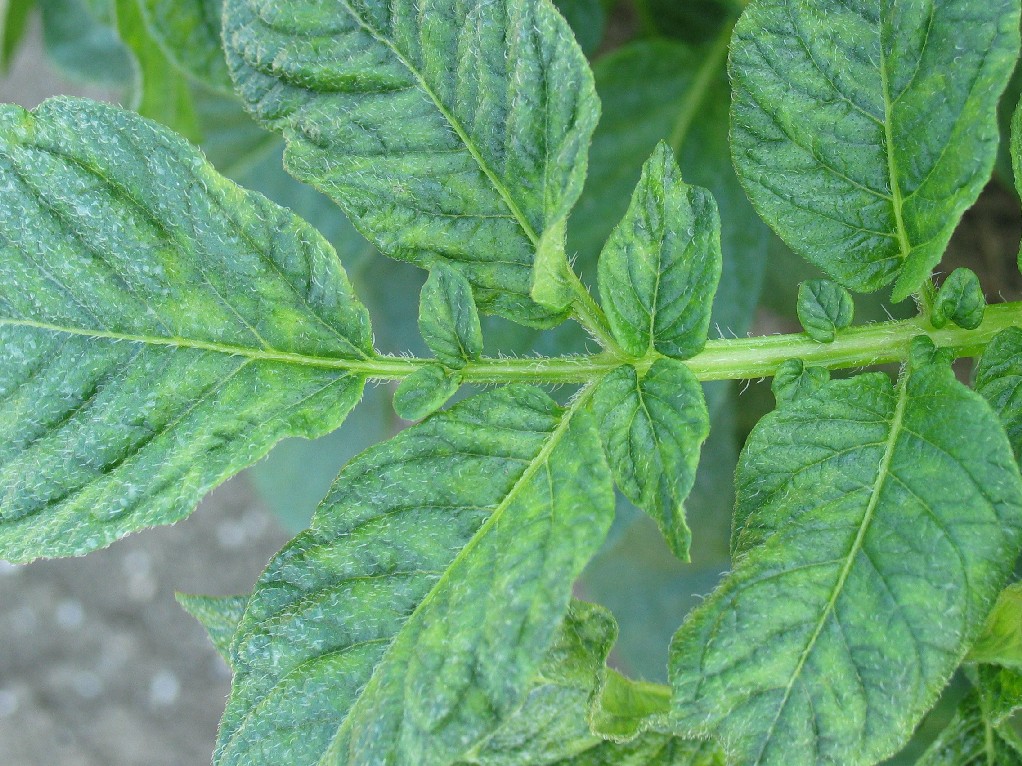
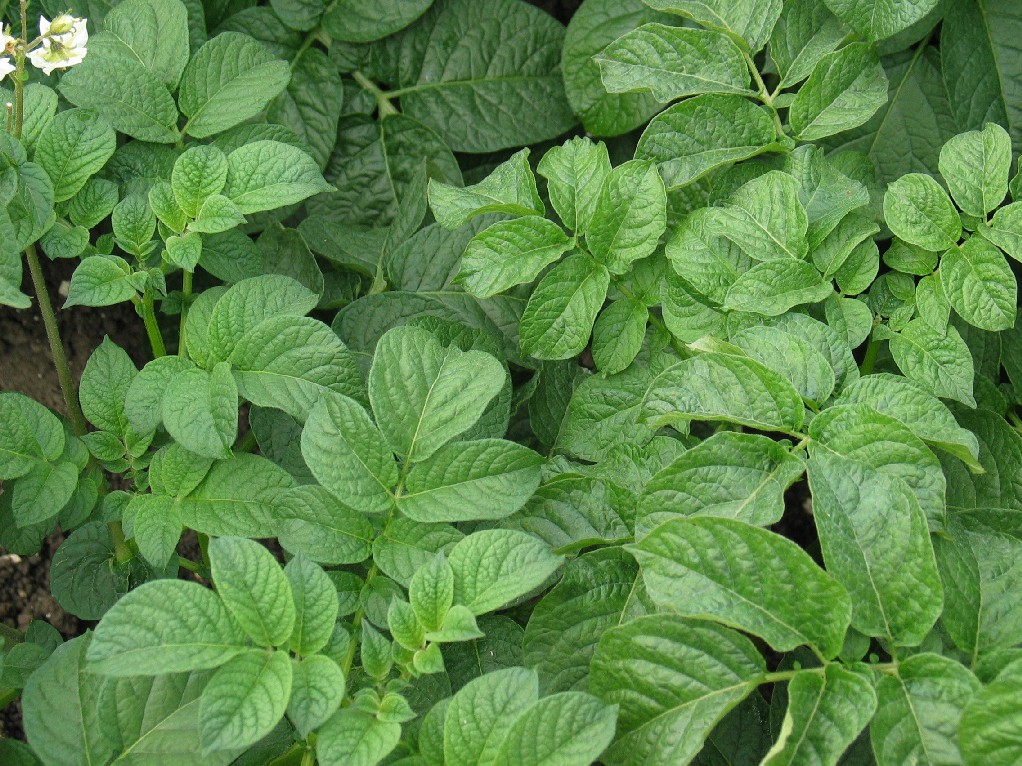 |
Tuber symptoms, regulated with tolerance in some regions |
| Virose légère |
Souches PVX, PVS et PVY, en particulier PVYN |
Tolérance définie (mosaïque légère) |
Observation individuelle de la plante et test ELISA |
Plante: décoloration ou marbrures des feuilles sans déformation
Tubercules: nécrose superficielle causée uniquement par la souche PVY |
Symptômes au niveau des tubercules. Dans certaines régions, ce parasite est réglementé, avec une tolérance |
| Мозаика обыкновенная |
Линии вирусов PVX, PVS и PVY, особенно PVYN |
Допуск для обыкновенной мозаики |
Визуальный осмотр растения и тест ELISA |
Ботва: обесцвечивание или крапчатость листьев без деформации
Клубень: поверхностный некроз вызывает только PVY |
Симтомы на клубнях; в некоторых регионах регулируется допуском |
 |
| Leafroll |
Potato leafroll virus (PLRV) |
Tolerance for severe virus |
Visual observation of plant and ELISA test |
Plant: rolling of leaves and stunting
Tuber: net necrosis in flesh |
|

 |
|
| Enroulement (Virus E) |
Virus de l’enroulement de la pomme de terre (PLRV) |
Virus réglementé avec tolérance définie (virus grave) |
Observation visuelle de la plante et test ELISA |
Sur la plante: enroulement des feuilles et rabougrissement
Sur les tubercules: nette nécrose de la chair |
|
| Скручивание листьев |
Вирус скручивания листьев картофеля (PLRV) |
Допуск для сильного вируса |
Визуальный осмотр растения и тест ELISA |
Ботва: скручивание листьев и чахлость стеблей
Клубень: некроз мякоти |
|
 |
Mop top
(Spraing in tubers) |
Potato mop-top virus (PMTV) |
Not regulated1 |
Visual observation of plant and tubers, ELISA test and PCR |
Plant: marked mottling of leaves and stunting of all or some stems. Yellow chevrons and blotching on leaves and stunting of all or some stems.
Tuber: necrotic rings or arcs on surface and in flesh |
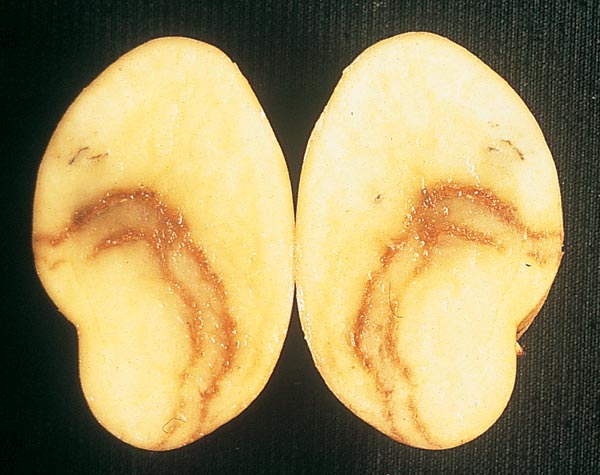
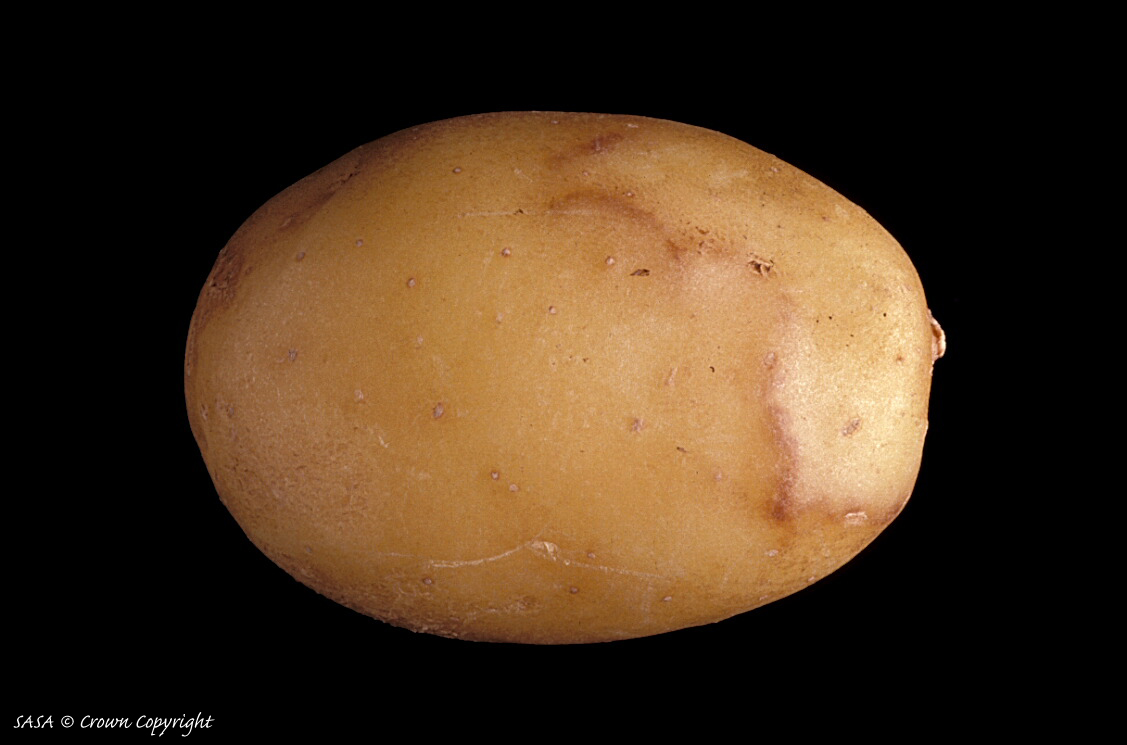 |
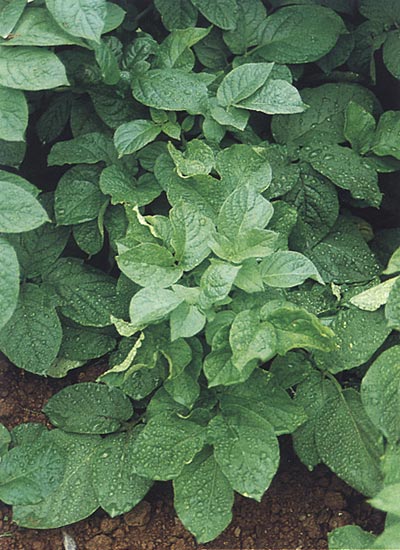
 |
Regulated with a zero tolerance in some regions |
| Mop top |
Virus PMTV |
Virus non réglementé1 |
Observation visuelle de la plante et des tubercules, test ELISA et PCR |
Plante: marbrures marquées des feuilles et atrophie de certaines tiges ou de la totalité d’entre elles
Tubercules: anneaux ou arcs nécrotiques en surface et pénétrant dans la chair |
Dans certaines régions, ce virus est réglementé, avec une tolérance zéro |
| "Моп-топ" (побурение мякоти клубней) |
Картофельный вирус моп-топ -курчавость |
Не регулируется1 |
Визуальное наблюдение растения и тест ELISA и ПЦР-анализ |
Ботва: выраженная крапчатость листьев и чахлость всех или некоторых стеблей
Клубень: некротические кольца или дуги на поверхности и в мякоти |
В некоторых регионах регулируется нулевым допуском |
 |
| Tobacco rattle virus (Spraing in tubers) |
Tobacco rattle virus |
Not regulated1 |
Observation of tubers and PCR |
Plant: mottling and distortion of leaves and stunting of some or all stems
Tuber: brown, corky arcs and spots in the tuber flesh which are sometimes visible on the skin surface |

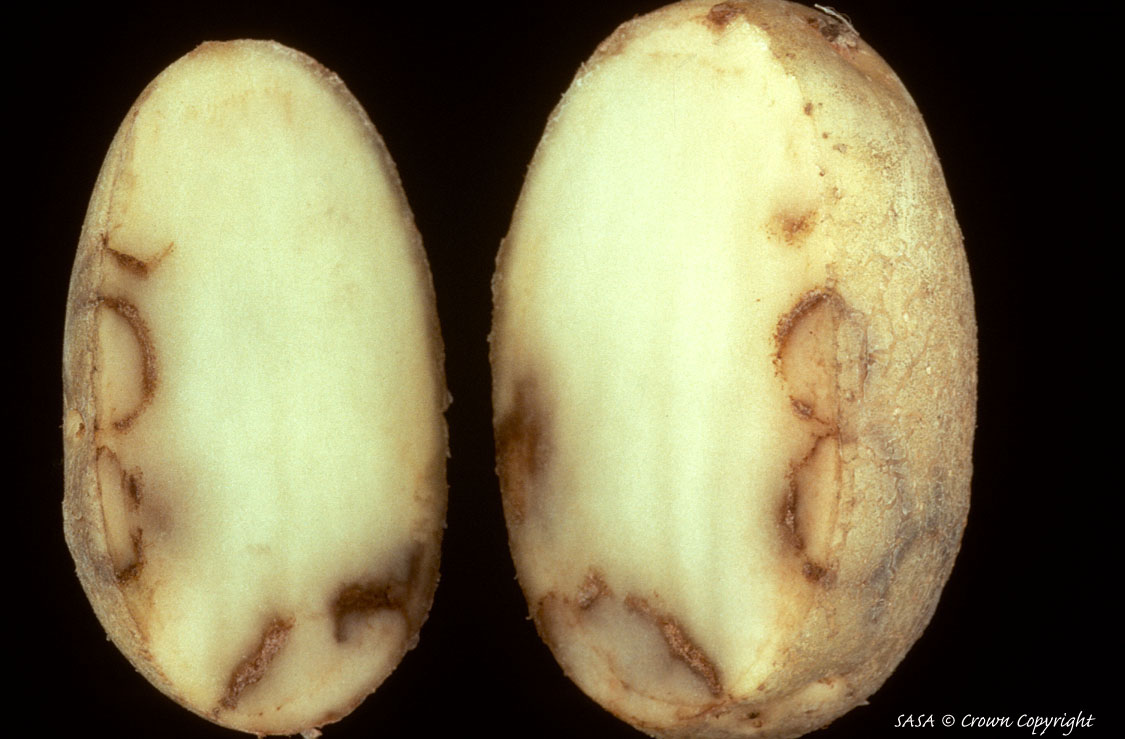 |
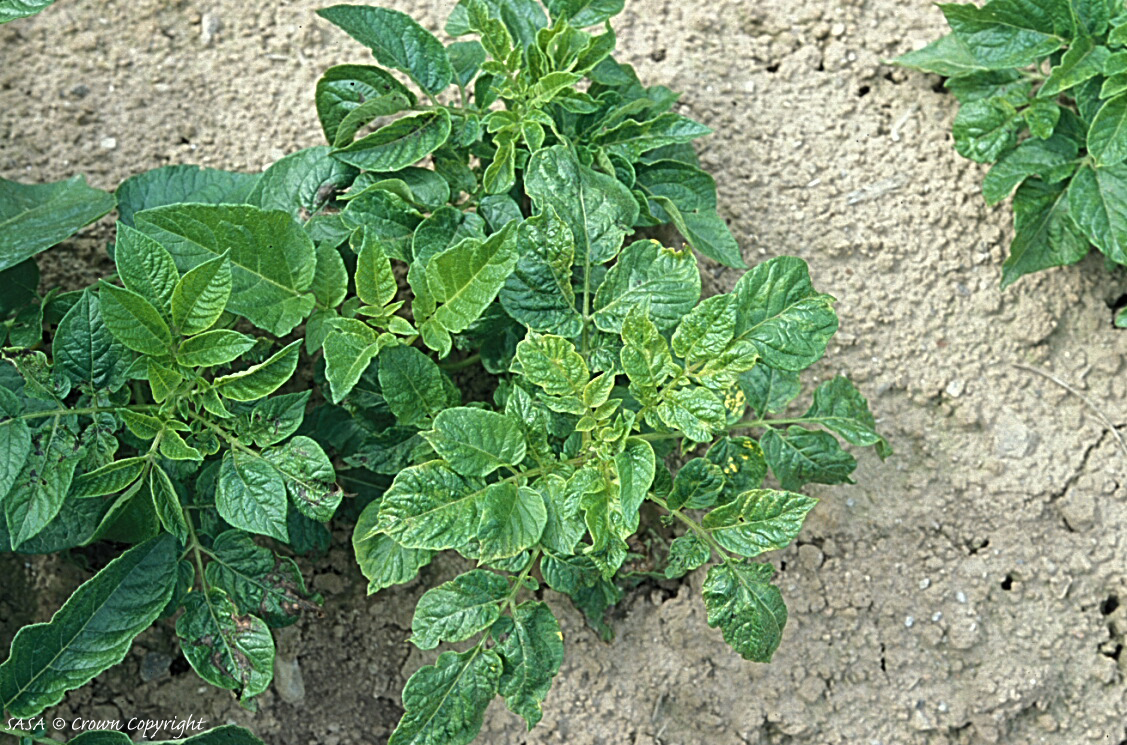 |
Regulated in some regions with tolerance |
| Rattle |
Virus du rattle |
Virus non réglementé1 |
Observation des tubercules et PCR |
Plante: marbrures et déformation des feuilles et atrophie de certaines tiges ou de la totalité d’entre elles
Tubercules: arcs et anneaux de décoloration internes, parfois visibles à la surface |
Dans certaines régions, ce virus est réglementé, avec des tolérances |
| Табачный вирус "рэттл" (побурение мякоти клубней) |
Табачный вирус "рэттл" |
Не регулируется1 |
Осмотр клубней и ПЦР-анализ |
Ботва: крапчатость и деформация листьев, чахлость стеблей
Клубень: появление в мякоти коричневатых дуг и колец, иногда видимых снаружи |
В некоторых регионах регулируется допуском |
 |
| Tomato spotted wilt virus |
Tomato spotted wilt virus |
Not regulated |
|
Plant: leaf spotting and necrosis
Tuber: skin blemish and internal necrotic spotting |
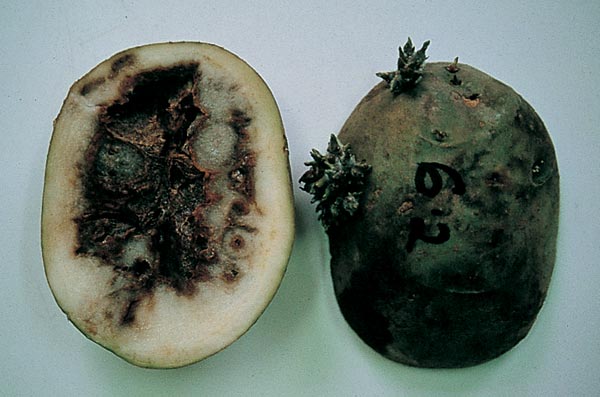 |
 |
Regulated in some regions
with zero tolerance |
| TSWV |
TSWV |
Virus non réglementé1 |
|
Plante: taches sur les feuilles et nécrose
Tubercules: taches sur l’épiderme et taches nécrotiques internes |
Dans certaines régions, ce virus est réglementé, avec une tolérance zéro |
| Вирус пятнистого увядания томатов |
Вирус пятнистого увядания томатов |
Не регулируется |
|
Ботва: пятнистость и некроз листьев
Клубень: пятна на кожуре и некротическая пятнистость мякоти |
В некоторых регионах регулируется нулевым допуском |
| BACTERIA BACTÉRIES БАКТЕРИИ |
| Blackleg |
Pectobacterium atrosepticum (syn. Erwinia carotovora subsp. atroseptica) and Pectobacterium carotovorum (syn. E. carotovora subsp. carotovora), Dickeya spp. (syn. E. chrysanthemi) |
Tolerance to crop and tuber for wet rot |
Observation of plant and tuber |
Plant: yellow, rolled upper leaves on blackleg plant; black slimy rots developing on stems.
Tuber: watery, soft rot of disintegrating flesh and pungent smell |


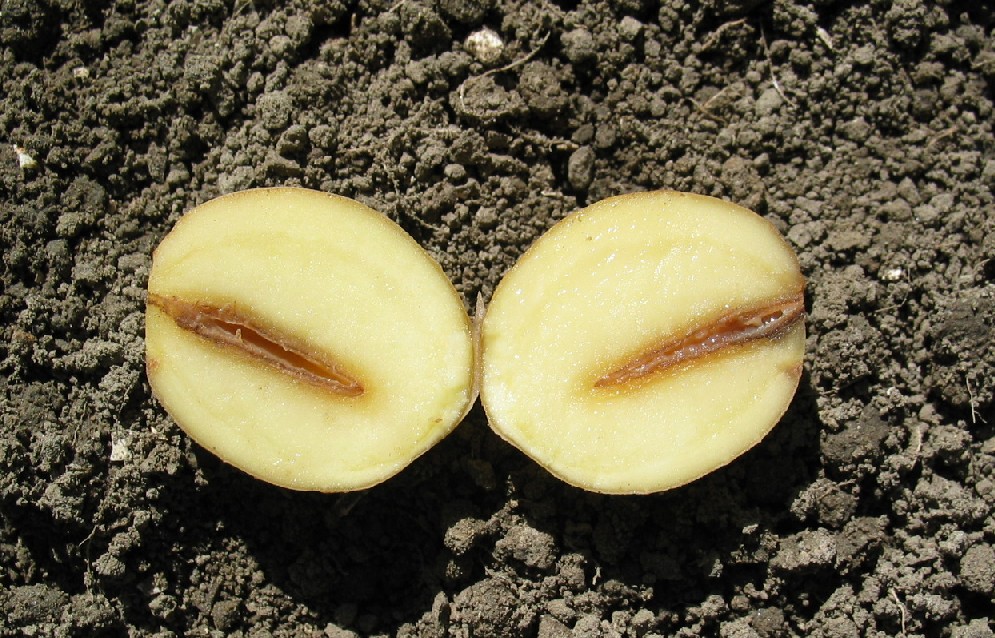
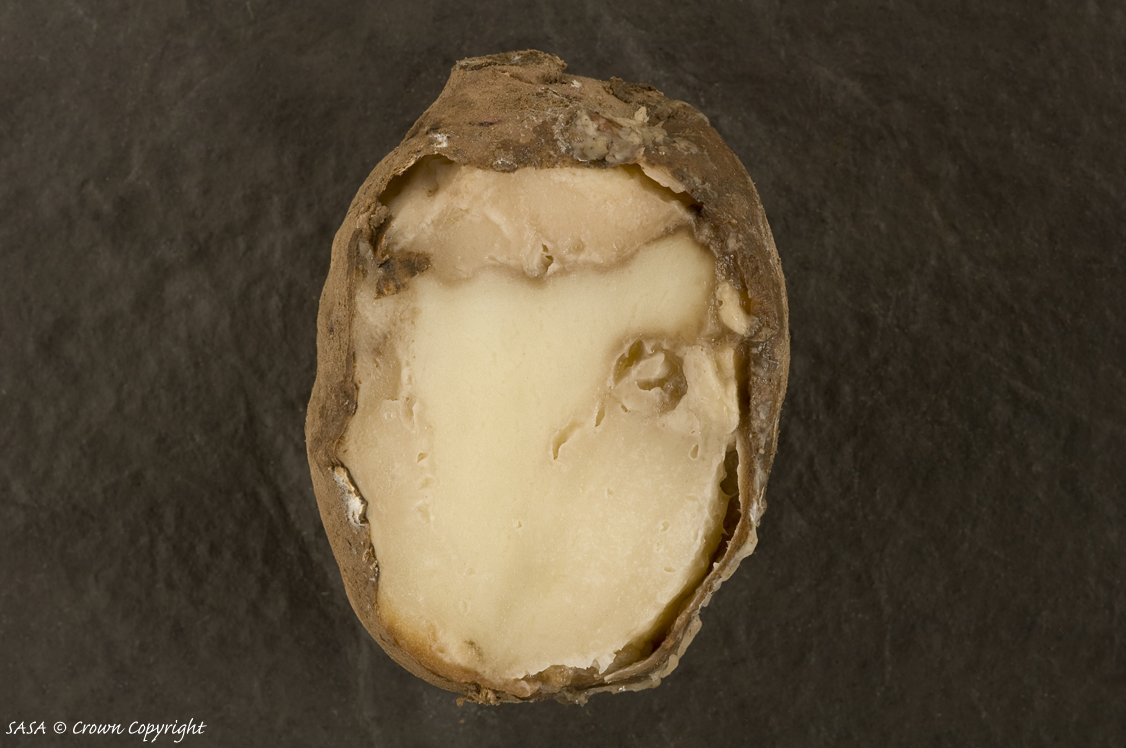
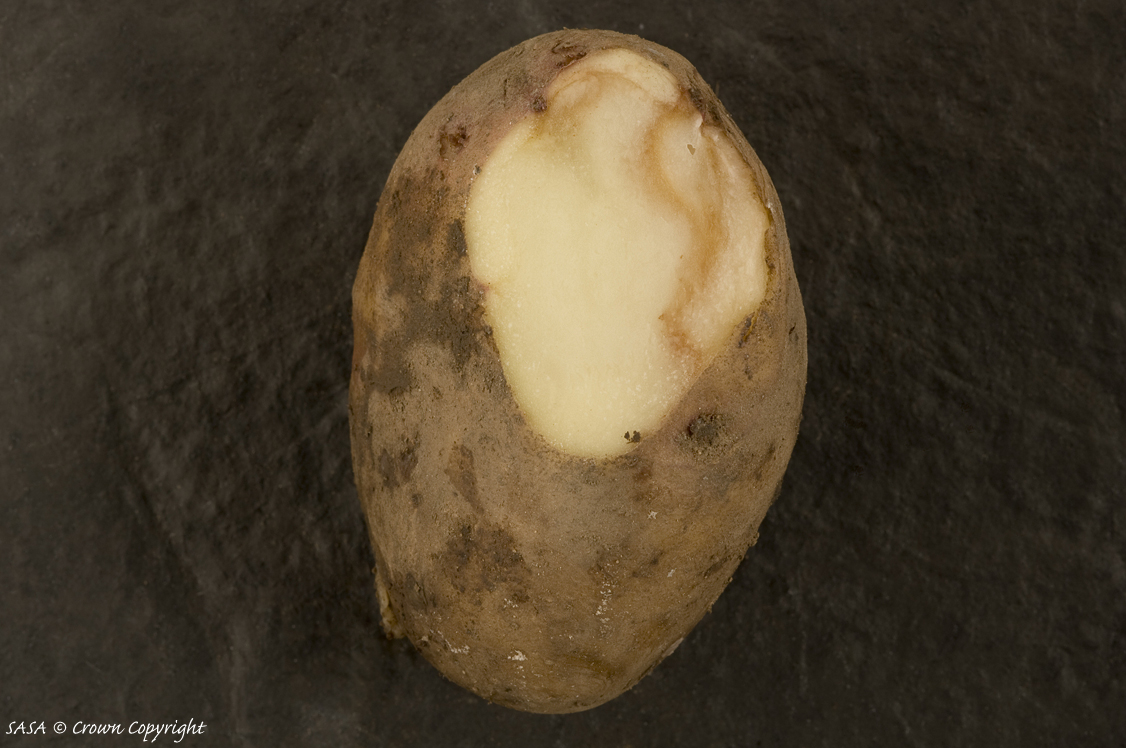 |
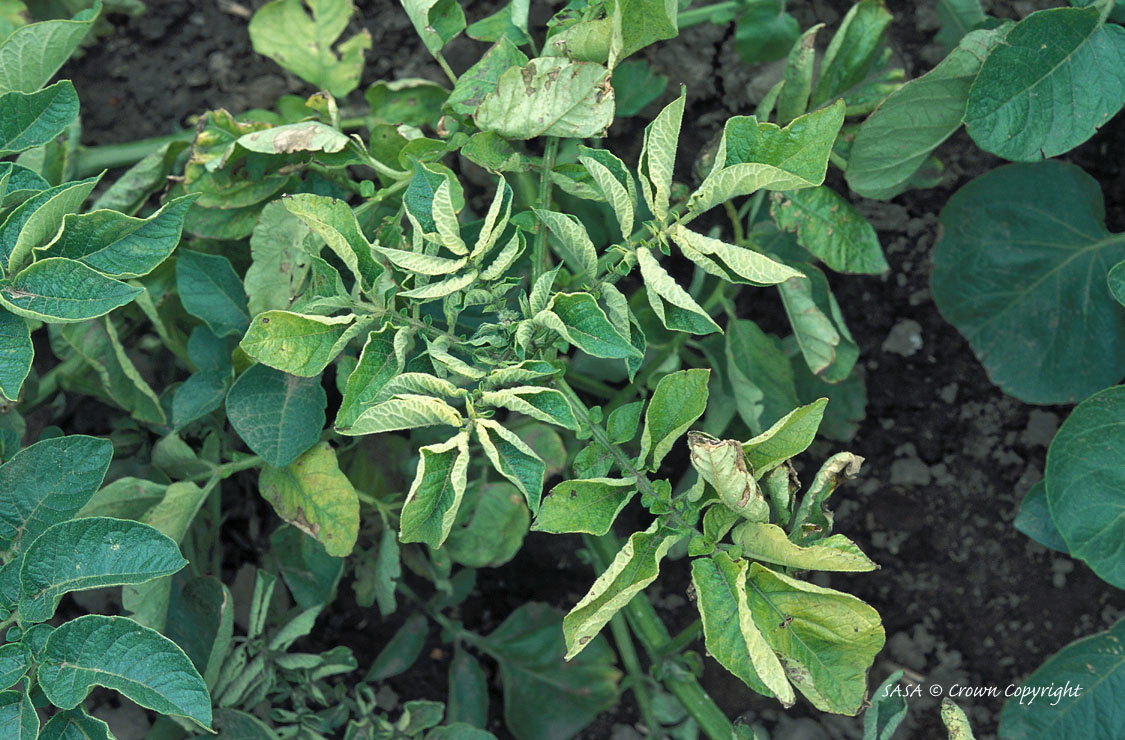

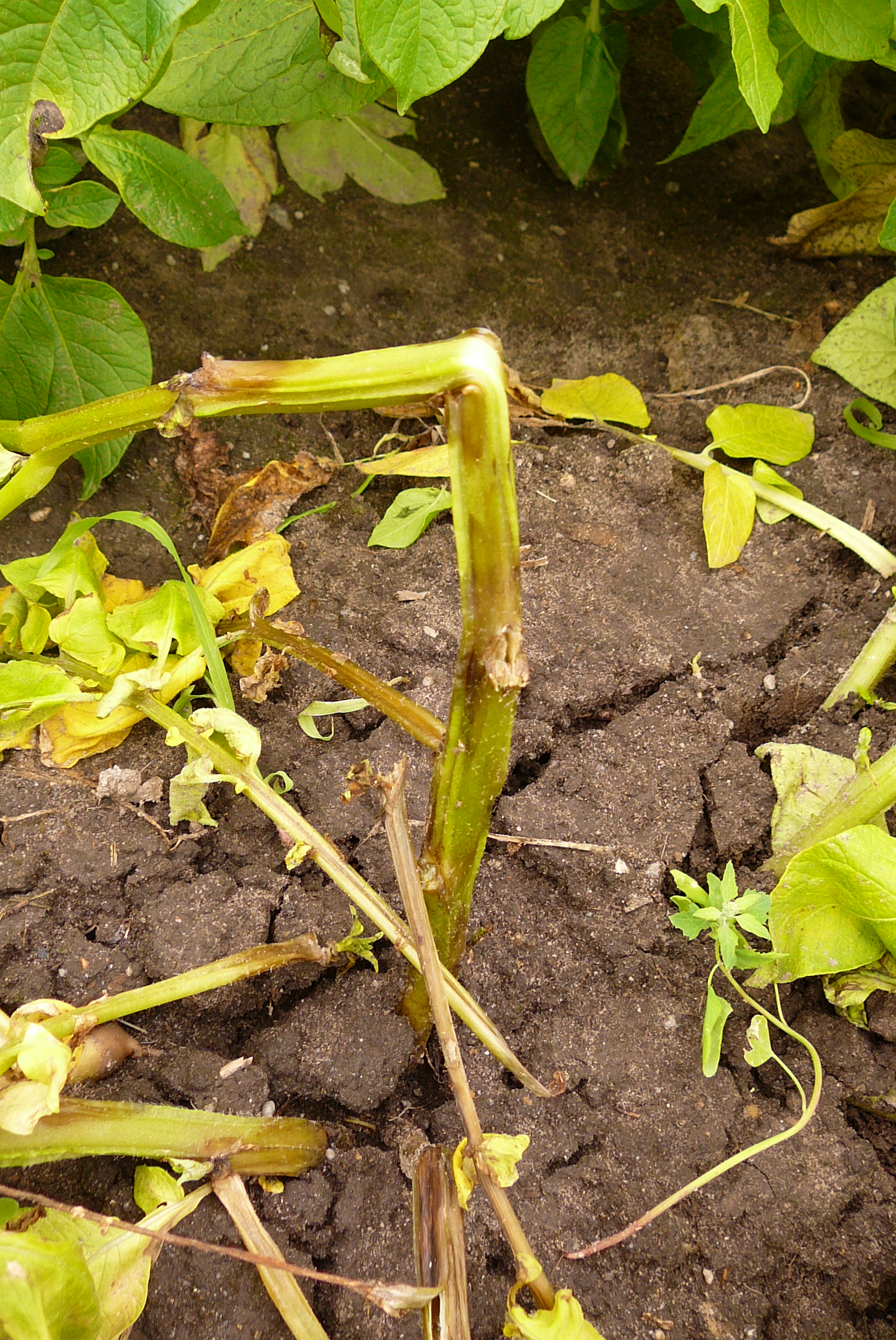 |
|
| Jambe noire |
Pectobacterium atrosepticum (syn. Erwinia carotovora subsp. atroseptica) et Pectobacterium carotovorum (auparavant. E. carotovora subsp. carotovora), Dickeya spp. (syn. E. chrysanthemi) |
Tolérances définies pour la culture et les tubercules (pourriture humide) |
Observation de la plante et du tubercule |
Plante: pourriture de la tige
Tubercules: pourriture molle |
|
| Черная ножка |
Pectobacterium Atrosepticum (син. Erwinia carotovora subsp. atroseptica) и
Pectobacterium carotovorum (прежде E. carotovora subsp. carotovora), Dickeya spp. (син. E. chrysanthemi) |
Допуск для растений и клубней по мокрой гнили |
Осмотр растений и клубней |
Ботва: желтые, свернутые верхние листья; черная склизская гниль на стеблях
Клубень: мокрая мягкая гниль разлагающейся ткани и острый запах |
|
 |
| Ring rot |
Clavibacter michiganensis subsp. sepedonicus |
Zero tolerance |
Observation of plant and tuber, test by IF and PCR |
Tuber: vascular soft rot
Plant: wilting and death |
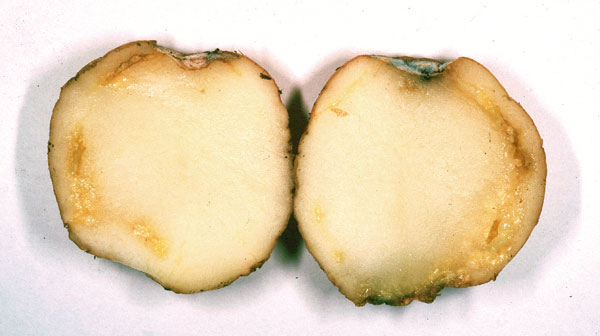 |
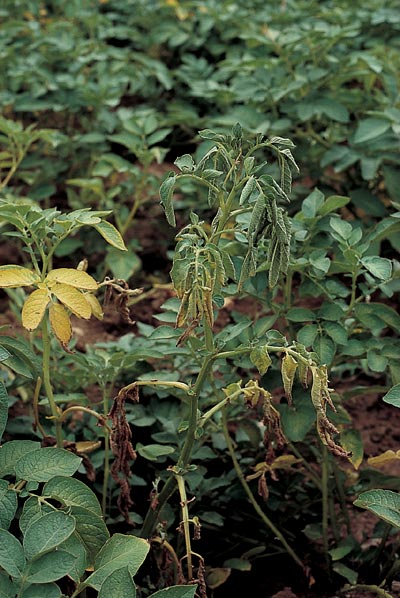 |
|
| Flétrissement bactérien, pourriture annulaire |
Clavibacter michiganensis subsp. sepedonicus |
Tolérance zéro |
Observation de la plante et du tubercule, test IF et PCR |
Tubercules: pourriture vasculaire molle
Plante: flétrissement et mort |
|
| Кольцевая гниль |
Clavibacter michiganensis subsp. sepedonicus |
Нулевой допуск |
Осмотр растений и клубней, тест IF и ПЦР-анализ |
Клубень: мягкая гниль сосудов
Ботва: увядание и отмирание |
|
 |
| Brown rot |
Ralstonia solanacearum |
Zero tolerance |
Observation of plant and tuber, test by IF and PCR |
Tuber: vascular soft rot
Plant: wilting |
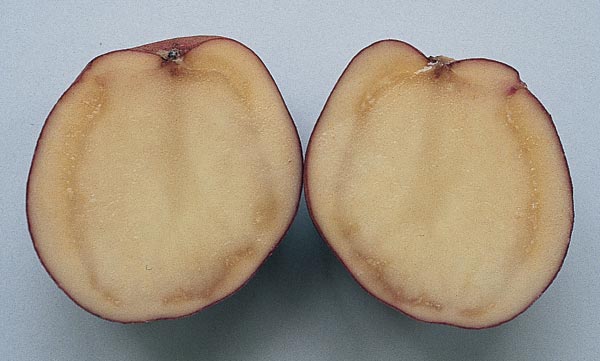 |
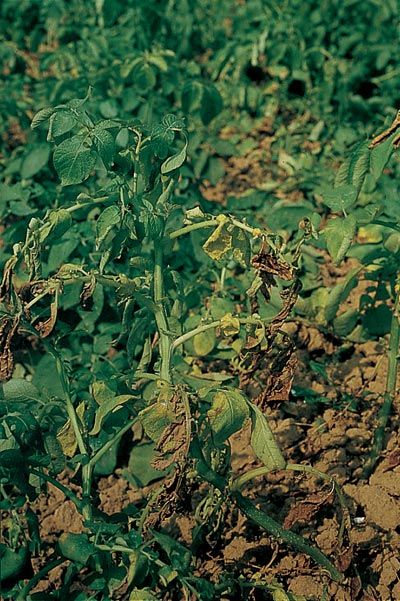 |
|
| Pourriture brune |
Ralstonia solanacearum |
Tolérance zéro |
Observation de la plante et du tubercule, test IF et PCR |
Tubercules: pourriture vasculaire molle
Plante: flétrissement |
|
| Бурая гниль |
Ralstonia solanacearum |
Нулевой допуск |
Осмотр растений и клубней, тест IF и ПЦР-анализ |
Клубень: мягкая гниль сосудов
Ботва: увядание |
|
 |
| Common scab |
Streptomyces scabiei and other S. strains, e.g. Streptomyces europaeiscabiei and S. stelliscabiei |
Tolerance on the tuber |
Observation of tuber |
Tuber: superficial, corky, irregular-shaped scabs on tuber surface; in severe cases, cracks may develop on the affected surfaces |
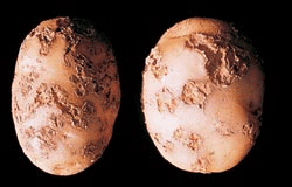 |
|
|
| Gale commune |
Streptomyces scabiei et autres souches S., par exemple:
Streptomyces europaeiscabiei, S. stelliscabiei |
Tolérance définie en ce qui concerne les tubercules |
Observation du tubercule |
Tubercules: pustules ou taches |
|
| Парша обыкновенная |
Streptomyces scabies и другие штаммы S., например, Streptomyces europaeiscabies и S. stelliscabies |
Допуск по площади поражения клубня |
Осмотр клубней |
Клубень: поверхностные бляшки неправильной формы; при сильном поражении могут появляться трещины |
|
 |
| Netted scab |
Streptomyces europaeiscabiei and Reticuliscabiei |
Tolerance on the tuber |
Observation of tuber |
Tuber: superficial netted scabs |
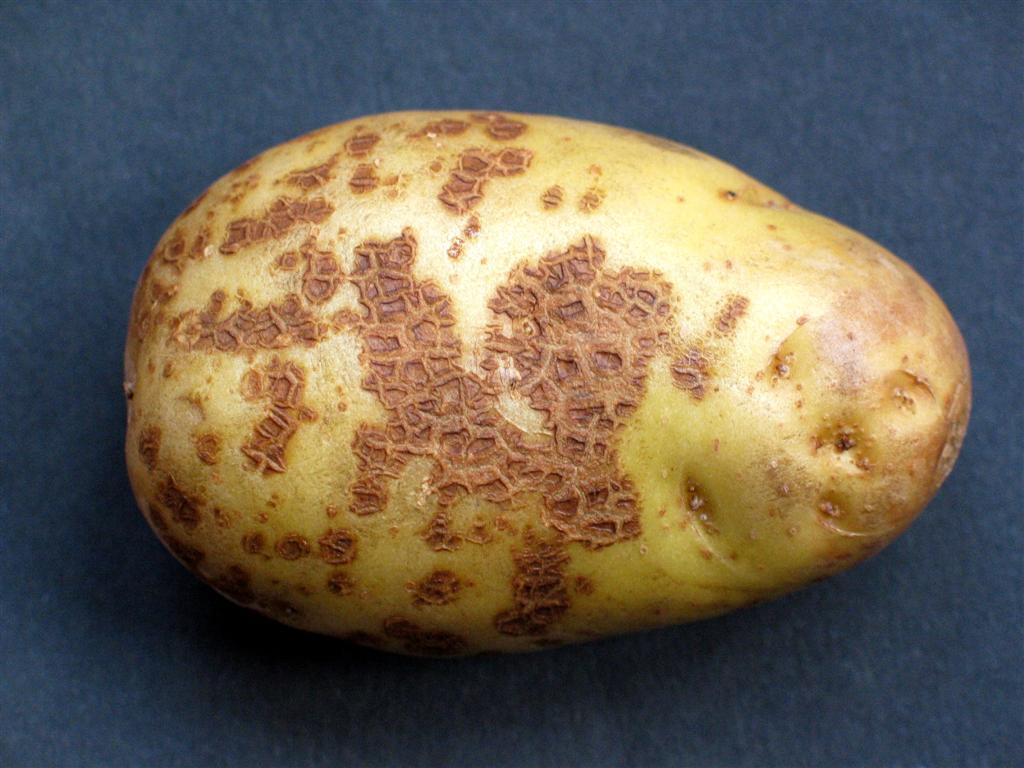 |
|
|
| Gale plate |
Streptomyces europaeiscabiei et Reticuliscabiei |
Tolérance définie en ce qui concerne les tubercules |
Observation du tubercule |
Tubercule: gales plates superficielles |
|
| Сетчатая парша |
Streptomyces europaeiscabiei и Reticuliscabiei |
Допуск по площади поражения клубня |
Осмотр клубней |
Клубень: поверхностные наросты сетчатой парши |
|
| VIROID VIROÏDE ВИРОИДЫ |
| Potato spindle tuber viroid |
Potato spindle tuber viroid (PSTV) |
Zero tolerance |
Observation of plant and tuber. Test by molecular hybridization and PCR |
Tuber: elongation of tuber
Plant: stunting and leaf rolling |
 |
|
|
| Viroïde des tubercules en fuseau |
PSTV |
Tolérance zéro |
Observation de la plante et du tubercule.
Test par hybridation moléculaire et PCR |
Tubercules: allongement des tubercules
Plante: rabougrissement et enroulement des feuilles |
|
| Веретеновидность клубней картофеля |
Вироид веретеновидности клубней картофеля |
Нулевой допуск |
Осмотр растений и клубней.
Метод молекулярной гибридизации и ПЦР-анализ |
Клубень: удлинение
Ботва: чахлость и скручивание листьев |
|
| PHYTOPLASMA PHYTOPLASME ФИТОПЛАЗМА |
| Stolbur |
Phytoplasma [The principal vectors are leafhoppers (Macrosteles spp, Hyalestes spp)]; |
Zero tolerance |
Visual observation of leaves and tubers |
Plant: stunting and leaf rolling |
 |
 |
In some regions regulated, zero tolerance |
| Stolbur |
Phytoplasma [Les principaux vecteurs sont des insectes de la famille des cicadelles (Macrosteles spp, Hyalestes spp)] |
Tolérance zéro |
Observation visuelle des feuilles et des tubercules |
Plante: rabougrissement et enroulement des feuilles et production de germes fileux par les tubercules provenant de plantes malades |
Est réglementé, avec une tolérance zéro, dans certaines régions |
| Столбур |
Фитоплазма [Основными переносчиками являются цикадки (Мacrosteles spp, Hyalestes spp)] |
Нулевой допуск |
Визуальный осмотр листьев и клубней |
Ботва: чахлость и скручивание листьев |
В некоторых регионах регулируется нулевым допуском |
| NEMATODES NÉMATODES НЕМАТОДЫ |
| Cyst nematodes |
Globodera rostochiensis and Globodera pallida |
Zero tolerance |
Visual observation of the field and testing of soil |
Plant: wilting and death |
 |
 |
|
| Nématodes à kystes de la pomme de terre |
Globodera rostochiensis et Globodera pallida |
Tolérance zéro |
Observation visuelle du champ et analyse de la terre |
Plante: flétrissement et mort |
|
| Картофельная цистообразующая нематода |
Globodera rostochiensis и Globodera pallida |
Нулевой допуск |
Визуальный осмотр поля и анализ почвы |
Ботва: увядание и отмирание |
|
 |
| Root knot nematodes |
Meloidogyne chitwoodi and fallax |
Zero tolerance |
Observation of tuber, microscopic examination of cut tuber, and PCR test |
Tuber: surface galls and internal necrotic spots |
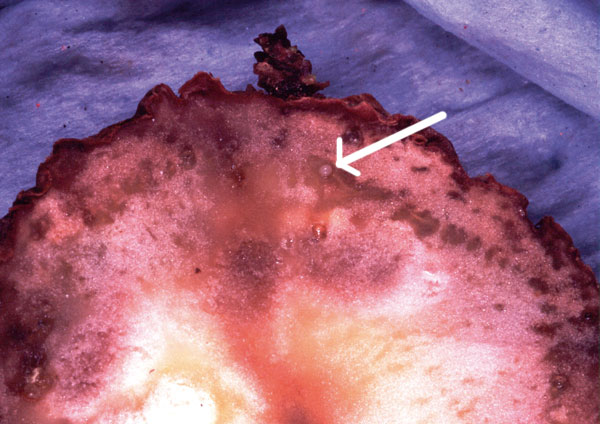
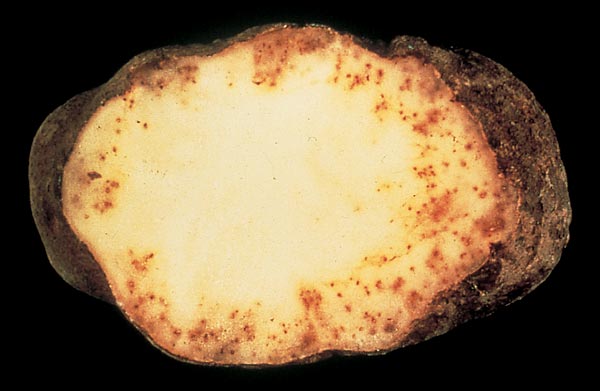 |
|
In some regions regulated, zero tolerance |
| Nématodes à galle des racines |
Meloidogyne chitwood et fallax |
Tolérance zéro |
Observation du tubercule, examen microscopique de coupes de tubercule et test PCR |
Tubercules: gales superficielles et taches nécrotiques internes |
Est réglementé, avec une tolérance zéro, dans certaines régions |
| Яванская галловая нематода |
Meloidogyne chitwoodi и fallax |
Нулевой допуск |
Осмотр клубней, микроскопическое исследование среза клубня и ПЦР-анализ |
Клубень: возникновение поверхностных галлов и некротических пятен на внутренних тканях |
В некоторых регионах регулируется нулевым допуском |
 |
| Potato rot nematode |
Ditylenchus destructor |
Zero tolerance |
Observation of tuber |
Tuber: surface cracking and cortical spotting |
 |
|
In some regions regulated, zero tolerance |
| Nématodes de la pomme de terre |
Ditylenchus destructor |
Tolérance zéro |
Observation du tubercule |
Sur les tubercules: craquelures de la surface et taches corticales |
Est réglementé, avec une tolérance zéro, dans certaines régions |
| Стеблевая нематода картофеля |
Ditylenchus destructor |
Нулевой допуск |
Осмотр клубней |
Клубень: растрескивание поверхности и корковая пятнистость |
В некоторых регионах регулируется нулевым допуском |
| PESTS RAVAGEURS НАСЕКОМЫЕ-ВРЕДИТЕЛИ |
| Colorado beetle |
Leptinotarsa decemlineata |
Unregulated |
Visual observation of eggs, larvae and adults |
Plant: leaf damage |
|
 |
In some regions regulated, zero tolerance |
| Doryphore |
Leptinotarsa decemlineata |
N’est pas réglementé |
Observation visuelle des œufs, des larves et des adultes |
Plante: dégâts sur les feuilles |
Est réglementé, avec une tolérance zéro, dans certaines régions |
| Колорадский жук |
Leptinotarsa decemlineata |
Не регулируется |
Визуальный осмотр: яйца, личинки, взрослые особи |
Ботва: повреждение листьев |
В некоторых регионах регулируется нулевым допуском |
 |
Wireworms/
slugs |
Agriotes sp.: A obscurus,
A. sputator, A. lineatus/ Tandonia budapestensis, Arion hortensis |
Unregulated |
Visual observation of tubers |
Tuber: tunnels and holes |
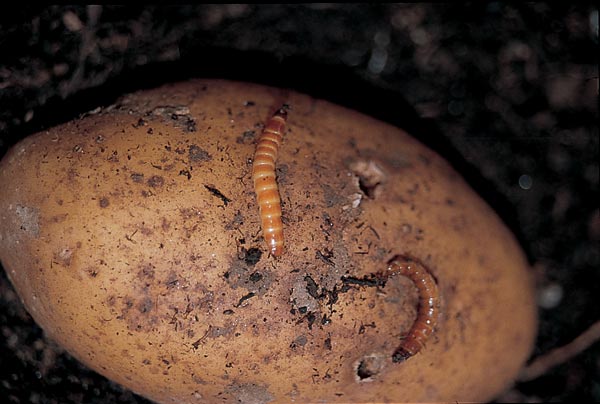
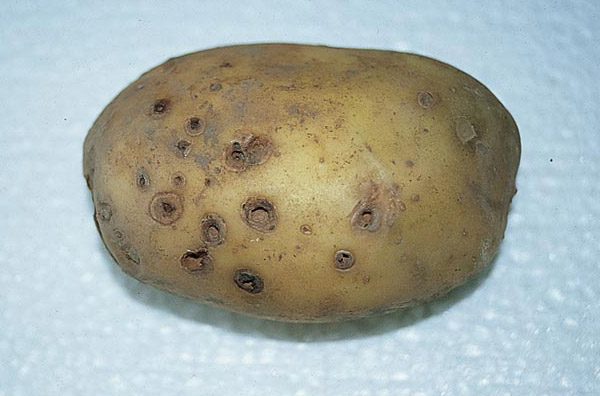 |
|
|
| Taupin |
Agriotes sp.: A obscurus, A. sputator, A. lineatus/ Tandonia budapestensis, Arion hortensis |
N’est pas réglementé |
Observation visuelle des tubercules |
Tubercules: formation de galeries et de trous |
|
| Проволочники/личинки |
Agriotes sp.: A obscurus, A. sputator, A. lineatus/ Tandonia budapestensis, Arion hortensis |
Не регулируется |
Визуальный осмотр клубней |
Клубни: ходы и отверстия |
|
 |
| Tuber moth |
Phthorimea opercullella |
Unregulated |
Visual observation of leaves and tubers |
Tuber: tunnels in flesh
Plant: leaf damage |

 |
|
In some regions regulated, zero tolerance |
| Teigne |
Phthorimea opercullella |
N’est pas réglementé |
Observation visuelle des feuilles et des tubercules |
Tubercules: galeries percées dans la chair
Plante: dégâts sur les feuilles |
Est réglementé, avec une tolérance zéro, dans certaines régions |
| Моль картофельная |
Phthorimea opercullella |
Не регулируется |
Визуальный осмотр листьев и клубней |
Клубни: образование ходов в мякоти
Ботва: повреждение листьев |
В некоторых регионах регулируется нулевым допуском |
 |
1 According to experience in certain areas, the disease can eradicate itself due to low transmission rates.
1 D’après ce que l’on a constaté dans certaines régions, la maladie peut s’auto éradiquer en raison des faibles taux de transmission.
1 Опыт некоторых рагионов показывает, что эта болезнь может исчезнуть самостоятельно из-за низкого коэффициента передачи. |